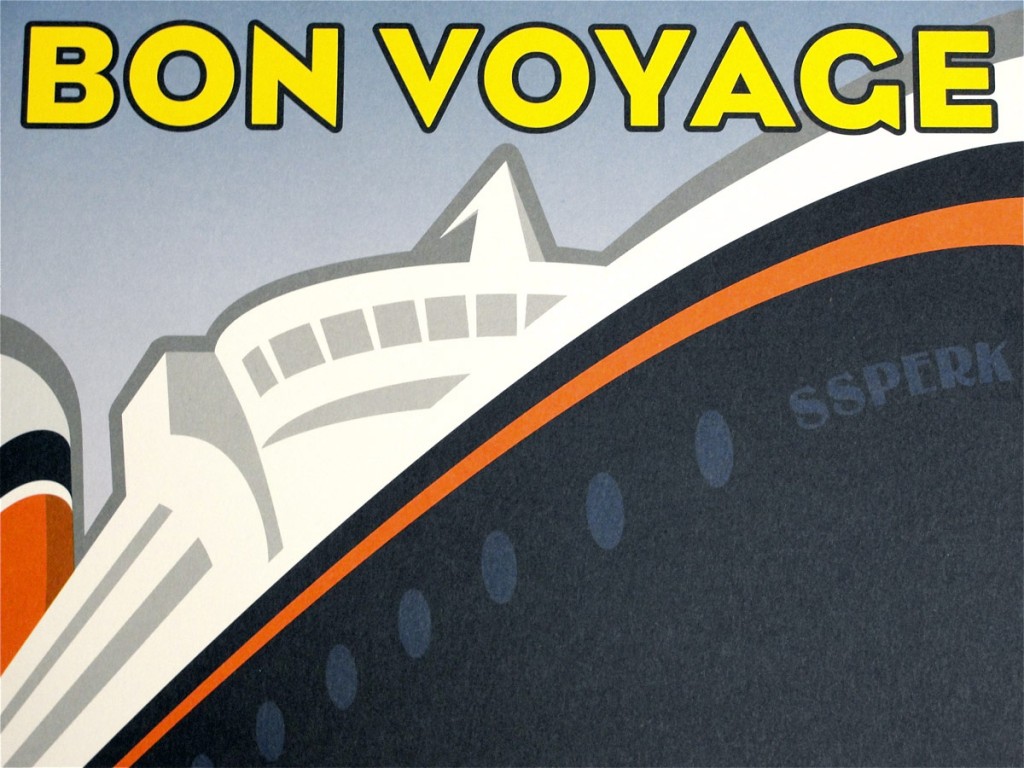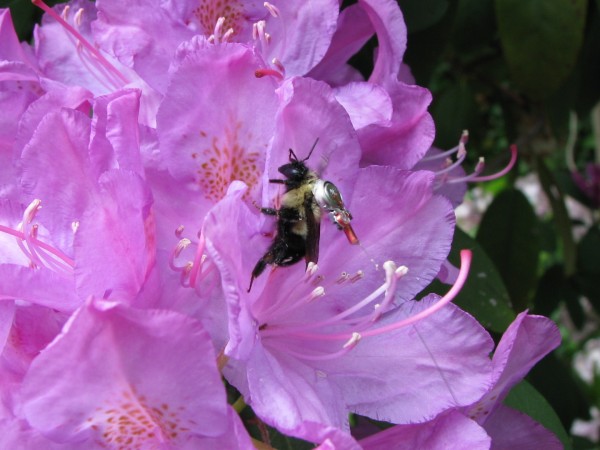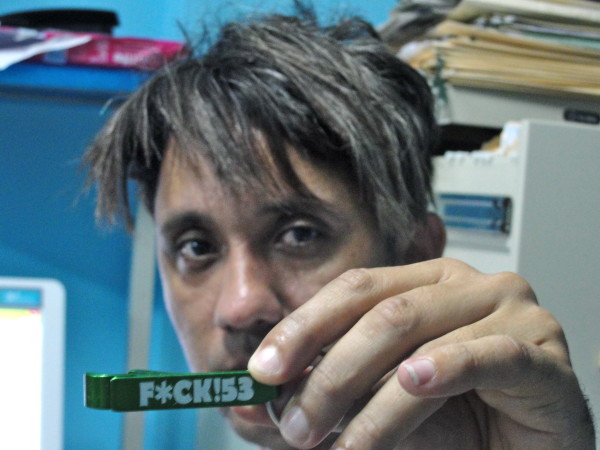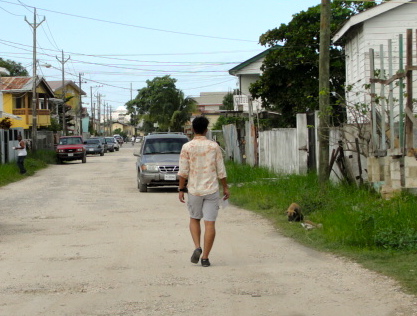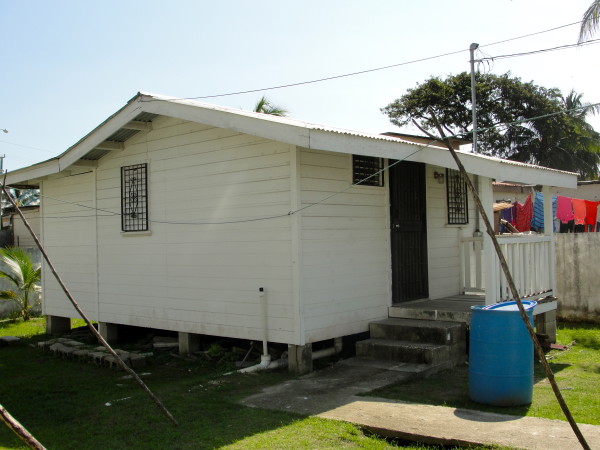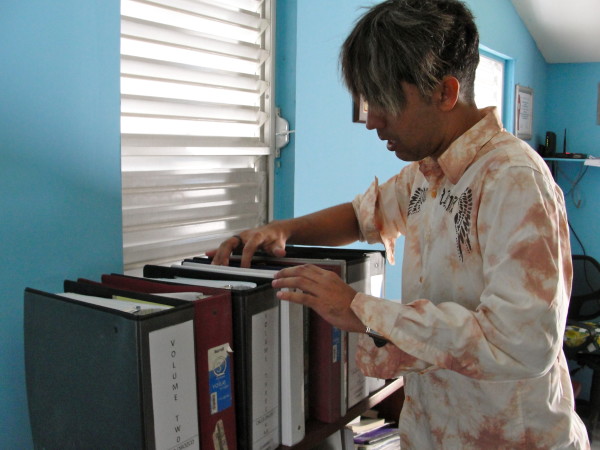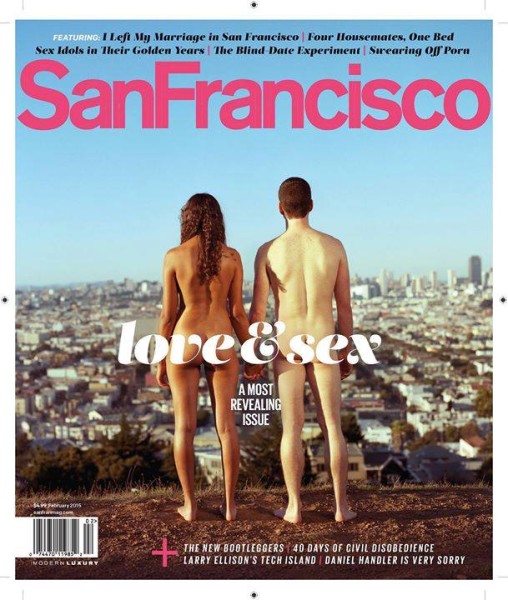
Posts Tagged ‘Julia Scott’
Heavyweight episode: “Julia”
Friday, June 6th, 2025
What happens when you go back and open the door to a time in your childhood that you tried to forget? Heavyweight host Jonathan Goldstein and I found out together.
Tags: bullies, bullying, Gimlet Media, Heavyweight, Jonathan Goldstein, Julia Scott, Montreal, podcast
Posted in Podcast and Radio Work | No Comments »
BON VOYAGE
Saturday, May 31st, 2025
The BBC Public Radio Partnership and producer Julia Scott present BON VOYAGE, the story of a same-sex couple from California who try to meet death in style.
Paul Perkovic and his husband, Eric Trefelner, have lived in style for 36 years. When they find out that Paul has inoperable pancreatic cancer, they decide he should go out in style, too. Eric plans a lavish, quarter million-dollar “Bon Voyage” party at a fine arts museum in San Francisco. Paul and Eric aren’t just planning a party; they’re trying to choreograph a death. But the couple soon discovers that death has its own agenda. BON VOYAGE brings the listener along on the intimate, emotional journey of a same-sex couple coping with mortality.
—
Praise for BON VOYAGE:
BON VOYAGE wins 2013 Excellence in Journalism award from the National Lesbian & Gay Journalists Association!
BON VOYAGE was nominated for Sony Radio Academy Award, Britain’s biggest radio honor.
RAVE REVIEW: The Guardian calls BON VOYAGE “Vivid and beautifully told… A tremendous listen: you felt as if you knew both subjects within moments, and got an insight into the hardest moments a relationship will face.”
—
BON VOYAGE is part of Real America, a new series from the BBC World Service that enlisted four American producers to tell stories found only in America. BON VOYAGE’s executive producer is Anne Donohue.
DURATION: 23 minutes.
Tags: BBC World Service, Bon Voyage, Eric Trefelner, Julia Scott, Paul Perkovic, PRX, Real America
Posted in Podcast and Radio Work | No Comments »
A Wash On the Wild Side: How I Learned To Stop Worrying and Love My Microbiome
Sunday, May 25th, 2025
For most of my life, if Iâve thought at all about the bacteria living on my skin, it has been while trying to scrub them away. But recently I spent four weeks rubbing them in. I was Subject 26 in testing a living bacterial skin tonic, developed by AOBiome, a biotech start-up in Cambridge, Mass. The tonic looks, feels and tastes like water, but each spray bottle of AO+ Refreshing Cosmetic Mist contains billions of cultivated Nitrosomonas eutropha, an ammonia-oxidizing bacteria (AOB) that is most commonly found in dirt and untreated water. AOBiome scientists hypothesize that it once lived happily on us too â before we started washing it away with soap and shampoo â acting as a built-in cleanser, deodorant, anti-inflammatory and immune booster by feeding on the ammonia in our sweat and converting it into nitrite and nitric oxide.
In the conference room of the cramped offices that the four-person AOBiome team rents at a start-up incubator, Spiros Jamas, the chief executive, handed me a chilled bottle of the solution from the refrigerator. âThese are AOB,â he said. âTheyâre very innocuous.â Because the N. eutropha are alive, he said, they would need to be kept cold to remain stable. I would be required to mist my face, scalp and body with bacteria twice a day. I would be swabbed every week at a lab, and the samples would be analyzed to detect changes in my invisible microbial community.
In the last few years, the microbiome (sometimes referred to as âthe second genomeâ) has become a focus for the health conscious and for scientists alike. Studies like the Human Microbiome Project, a national enterprise to sequence bacterial DNA taken from 242 healthy Americans, have tagged 19 of our phyla (groupings of bacteria), each with thousands of distinct species. As Michael Pollan wrote in this magazine last year: âAs a civilization, weâve just spent the better part of a century doing our unwitting best to wreck the human-associated microbiota. . . . Whether any cures emerge from the exploration of the second genome, the implications of what has already been learned â for our sense of self, for our definition of health and for our attitude toward bacteria in general â are difficult to overstate.â
While most microbiome studies have focused on the health implications of whatâs found deep in the gut, companies like AOBiome are interested in how we can manipulate the hidden universe of organisms (bacteria, viruses and fungi) teeming throughout our glands, hair follicles and epidermis. They see long-term medical possibilities in the idea of adding skin bacteria instead of vanquishing them with antibacterials â the potential to change how we diagnose and treat serious skin ailments. But drug treatments require the approval of the Food and Drug Administration, an onerous and expensive process that can take upward of a decade. Instead, AOBiomeâs founders introduced AO+ under the loosely regulated âcosmeticsâ umbrella as a way to release their skin tonic quickly. With luck, the sales revenue will help to finance their research into drug applications. âThe cosmetic route is the quickest,â Jamas said. âThe other route is the hardest, the most expensive and the most rewarding.â
AOBiome does not market its product as an alternative to conventional cleansers, but it notes that some regular users may find themselves less reliant on soaps, moisturizers and deodorants after as little as a month. Jamas, a quiet, serial entrepreneur with a doctorate in biotechnology, incorporated N. eutropha into his hygiene routine years ago; today he uses soap just twice a week. The chairman of the companyâs board of directors, Jamie Heywood, lathers up once or twice a month and shampoos just three times a year. The most extreme case is David Whitlock, the M.I.T.-trained chemical engineer who invented AO+. He has not showered for the past 12 years. He occasionally takes a sponge bath to wash away grime but trusts his skinâs bacterial colony to do the rest. I met these men. I got close enough to shake their hands, engage in casual conversation and note that they in no way conveyed a sense of being âuncleanâ in either the visual or olfactory sense.
For my part in the AO+ study, I wanted to see what the bacteria could do quickly, and I wanted to cut down on variables, so I decided to sacrifice my own soaps, shampoo and deodorant while participating. I was determined to grow a garden of my own.
Week One
The story of AOBiome begins in 2001, in a patch of dirt on the floor of a Boston-area horse stable, where Whitlock was collecting soil samples. A few months before, an equestrienne he was dating asked him to answer a question she had long been curious about: Why did her horse like to roll in the dirt? Whitlock didnât know, but he saw an opportunity to impress.
Whitlock thought about how much horses sweat in the summer. He wondered whether the animals managed their sweat by engaging in dirt bathing. Could there be a kind of âgoodâ bacteria in the dirt that fed off perspiration? He knew there was a class of bacteria that derive their energy from ammonia rather than from carbon and grew convinced that horses (and possibly other mammals that engage in dirt bathing) would be covered in them. âThe only way that horses could evolve this behavior was if they had substantial evolutionary benefits from it,â he told me.
Whitlock gathered his samples and brought them back to his makeshift home laboratory, where he skimmed off the dirt and grew the bacteria in an ammonia solution (to simulate sweat). The strain that emerged as the hardiest was indeed an ammonia oxidizer: N. eutropha. Here was one way to test his âclean dirtâ theory: Whitlock put the bacteria in water and dumped them onto his head and body.
Some skin bacteria species double every 20 minutes; ammonia-oxidizing bacteria are much slower, doubling only every 10 hours. They are delicate creatures, so Whitlock decided to avoid showering to simulate a pre-soap living condition. âI wasnât sure what would happen,â he said, âbut I knew it would be good.â
The bacteria thrived on Whitlock. AO+ was created using bacterial cultures from his skin.
And now the bacteria were on my skin.
I had warned my friends and co-workers about my experiment, and while there were plenty of jokes â someone left a stick of deodorant on my desk; people started referring to me as âTeen Spiritâ â when I pressed them to sniff me after a few soap-free days, no one could detect a difference. Aside from my increasingly greasy hair, the real changes were invisible. By the end of the week, Jamas was happy to see test results that showed the N. eutropha had begun to settle in, finding a friendly niche within my biome.
Week Two
AOBiome is not the first company to try to leverage emerging discoveries about the skin microbiome into topical products. The skin-care aisle at my drugstore had a moisturizer with a âprobiotic complex,â which contains an extract of Lactobacillus, species unknown. Online, companies offer face masks, creams and cleansers, capitalizing on the booming market in probiotic yogurts and nutritional supplements. There is even a âfrozen yogurtâ body cleanser whose second ingredient is sodium lauryl sulfate, a potent detergent, so you can remove your healthy bacteria just as fast as you can grow them.
Audrey Gueniche, a project director in LâOrĂ©alâs research and innovation division, said the recent skin microbiome craze âhas revolutionized the way we study the skin and the results we look for.â LâOrĂ©al has patented several bacterial treatments for dry and sensitive skin, including Bifidobacterium longum extract, which it uses in a LancĂŽme product. Clinique sells a foundation with Lactobacillus ferment, and its parent company, EstĂ©e Lauder, holds a patent for skin application of Lactobacillus plantarum. But itâs unclear whether the probiotics in any of these products would actually have any effect on skin: Although a few studies have shown that Lactobacillus may reduce symptoms of eczema when taken orally, it does not live on the skin with any abundance, making it âa curious place to start for a skin probiotic,â said Michael Fischbach, a microbiologist at the University of California, San Francisco. Extracts are not alive, so they wonât be colonizing anything.
To differentiate their product from others on the market, the makers of AO+ use the term âprobioticsâ sparingly, preferring instead to refer to âmicrobiomics.â No matter what their marketing approach, at this stage the company is still in the process of defining itself. It doesnât help that the F.D.A. has no regulatory definition for âprobioticâ and has never approved such a product for therapeutic use. âThe skin microbiome is the wild frontier,â Fischbach told me. âWe know very little about what goes wrong when things go wrong and whether fixing the bacterial community is going to fix any real problems.â
I didnât really grasp how much was yet unknown until I received my skin swab results from Week 2. My overall bacterial landscape was consistent with the majority of Americansâ: Most of my bacteria fell into the genera Propionibacterium, Corynebacterium and Staphylococcus, which are among the most common groups. (S. epidermidis is one of several Staphylococcus species that reside on the skin without harming it.) But my test results also showed hundreds of unknown bacterial strains that simply havenât been classified yet.
Meanwhile, I began to regret my decision to use AO+ as a replacement for soap and shampoo. People began asking if Iâd âdone something newâ with my hair, which turned a full shade darker for being coated in oil that my scalp wouldnât stop producing. I slept with a towel over my pillow and found myself avoiding parties and public events. Mortified by my body odor, I kept my arms pinned to my sides, unless someone volunteered to smell my armpit. One friend detected the smell of onions. Another caught a whiff of âpleasant pot.â
When I visited the gym, I followed AOBiomeâs instructions, misting myself before leaving the house and again when I came home. The results: After letting the spray dry on my skin, I smelled better. Not odorless, but not as bad as I would have ordinarily. And, oddly, my feet didnât smell at all.
Week Three
My skin began to change for the better. It actually became softer and smoother, rather than dry and flaky, as though a saunaâs worth of humidity had penetrated my winter-hardened shell. And my complexion, prone to hormone-related breakouts, was clear. For the first time ever, my pores seemed to shrink. As I took my morning âshowerâ â a three-minute rinse in a bathroom devoid of hygiene products â I remembered all the antibiotics I took as a teenager to quell my acne. How funny it would be if adding bacteria were the answer all along.
Dr. Elizabeth Grice, an assistant professor of dermatology at the University of Pennsylvania who studies the role of microbiota in wound healing and inflammatory skin disease, said she believed that discoveries about the second genome might one day not only revolutionize treatments for acne but also â as AOBiome and its biotech peers hope â help us diagnose and cure disease, heal severe lesions and more. Those with wounds that fail to respond to antibiotics could receive a probiotic cocktail adapted to fight the specific strain of infecting bacteria. Body odor could be altered to repel insects and thereby fight malaria and dengue fever. And eczema and other chronic inflammatory disorders could be ameliorated.
According to Julie Segre, a senior investigator at the National Human Genome Research Institute and a specialist on the skin microbiome, there is a strong correlation between eczema flare-ups and the colonization of Staphylococcus aureus on the skin. Segre told me that scientists donât know what triggers the bacterial bloom. But if an eczema patient could monitor their microbes in real time, they could lessen flare-ups. âJust like someone who has diabetes is checking their blood-sugar levels, a kid who had eczema would be checking their microbial-diversity levels by swabbing their skin,â Segre said.
AOBiome says its early research seems to hold promise. In-house lab results show that AOB activates enough acidified nitrite to diminish the dangerous methicillin-resistant Staphylococcus aureus (MRSA). A regime of concentrated AO+ caused a hundredfold decrease of Propionibacterium acnes, often blamed for acne breakouts. And the company says that diabetic mice with skin wounds heal more quickly after two weeks of treatment with a formulation of AOB.
Soon, AOBiome will file an Investigational New Drug Application with the F.D.A. to request permission to test more concentrated forms of AOB for the treatment of diabetic ulcers and other dermatologic conditions. âItâs very, very easy to make a quack therapy; to put together a bunch of biological links to convince someone that somethingâs true,â Heywood said. âWhat would hurt us is trying to sell anything ahead of the data.â
Week Four
As my experiment drew to a close, I found myself reluctant to return to my old routine of daily shampooing and face treatments. A month earlier, I packed all my hygiene products into a cooler and hid it away. On the last day of the experiment, I opened it up, wrinkling my nose at the chemical odor. Almost everything in the cooler was a synthesized liquid surfactant, with lab-manufactured ingredients engineered to smell good and add moisture to replace the oils they washed away. I asked AOBiome which of my products was the biggest threat to the âgoodâ bacteria on my skin. The answer was equivocal: Sodium lauryl sulfate, the first ingredient in many shampoos, may be the deadliest to N. eutropha, but nearly all common liquid cleansers remove at least some of the bacteria. Antibacterial soaps are most likely the worst culprits, but even soaps made with only vegetable oils or animal fats strip the skin of AOB.
Bar soaps donât need bacteria-killing preservatives the way liquid soaps do, but they are more concentrated and more alkaline, whereas liquid soaps are often milder and closer to the natural pH of skin. Which is better for our bacteria? âThe short answer is, we donât know,â said Dr. Larry Weiss, founder of CleanWell, a botanical-cleanser manufacturer. Weiss is helping AOBiome put together a list of âbacteria-safeâ cleansers based on lab testing. In the end, I tipped most of my products into the trash and purchased a basic soap and a fragrance-free shampoo with a short list of easily pronounceable ingredients. Then I enjoyed a very long shower, hoping my robust biofilm would hang on tight.
One week after the end of the experiment, though, a final skin swab found almost no evidence of N. eutropha anywhere on my skin. It had taken me a month to coax a new colony of bacteria onto my body. It took me three showers to extirpate it. Billions of bacteria, and they had disappeared as invisibly as they arrived. I had come to think of them as âmine,â and yet I had evicted them.
– – –
BONUS: Eavesdrop on Julia’s conversation with The 6th Floor blog at the New York Times.
Tags: AOBiome, Bacteria, Bacteria skin spray, Julia Scott, Julie Segre, Lactobacillus, Michael Fischbach, New York Times Magazine, Nitrosomonas Eutropha, No poo, Probiotic cleanser, Probiotic cosmetics, Probiotic FDA regulation, Probiotics, Skin microbiome, Sodium laurel sulfate
Posted in Front Page | No Comments »
The Last of the Iron Lungs
Thursday, May 15th, 2025
Martha Lillard is one of the last American polio victims who still rely on an iron lung respirator to breathe. Ten years ago, she was one of 30. Today, a dozen. But Martha, like other survivors, says she would rather end her life in her iron lung than risk using a modern replacement. THE LAST OF THE IRON LUNGS brings listeners inside an archaic machine â and a way of life â on the brink of extinction.
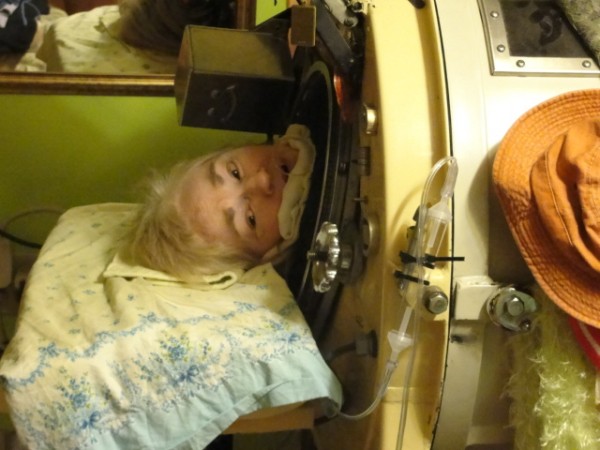 This program is part of the STEM Story Project — distributed by PRX and made possible with funds from the Alfred P. Sloan Foundation.
This program is part of the STEM Story Project — distributed by PRX and made possible with funds from the Alfred P. Sloan Foundation.
Special thanks to the March of Dimes for its archival newsreel. The March of Dimes Foundation is a United States nonprofit organization that works to improve the health of mothers and babies.
Tags: history of polio, iron lung, Julia Scott, March of Dimes, Martha Lillard, polio, polio survivor, PRX, respirators
Posted in Podcast and Radio Work | No Comments »
Tracking honeybees to save them
Thursday, May 1st, 2025
If anyone living in the village of Möggingen, Germany, had taken a close look at a bumblebee in the summer of 2009, they might have noticed something a little strange. Some of the bees were wearing what looked like small silvery backpacks with 3-inch antennae, zipping between trees and flower heads. A scientist followed discreetly behind.
The beesâ accessory was a tiny transmitter with a radar-detection range over a third of a mile. For the first time, Dr. Martin Wikelski and his colleagues at the Max Planck Institute for Ornithology succeeded in tracking bumblebees as they alighted on pear trees and nipped across meadows in idyllic and rural Germany. The study found that the bees flew up to 1.5 miles and explored areas over 100 acres, repeatedly visiting the same tree or flower patch to rest or forage. The poor bees were working hard. Given that a bumblebee weighs about 300 milligrams, packing the transmitter was the equivalent of a 150-pound person spending each day with a 100-pound barbell strapped to her back.
The backpacking bumblebees were not only a curious sight but a potential model for solving a puzzling biological mystery, colony collapse disorder (CCD), which is decimating honeybees, the bumblebeesâ smaller cousin. The seasonal epidemic eliminates at least one-third of all commercial honeybee colonies in the United States each year. This past winter, 45 percent of U.S. beekeepers, including backyard beekeepers, watched their bees abandon their hives, a 78 percent increase over the previous year, according to an annual survey funded by the U.S. Department of Agriculture.
In a recent interview, Wikelski says tracking honeybees with radio telemetry would allow scientists to identify trouble spots where the bees may come in contact with the viruses, bacteria, mites, and pesticides linked to their premature deaths. By monitoring the beesâ flights, scientists could determine a change in behavior and perhaps discover why the bees die. âThe bees would tell us what they do and what they see out there,â Wikelski says. âWe could use that information to protect them.â
Some of the bees were wearing what looked like small silvery backpacks with 3-inch antennae, zipping between trees and flower heads.
Current radio trackers arenât small or light enough to attach to honeybees, which weigh roughly a twelfth of a gram, or 120 mg, slightly more than a fat raindrop. But Wikelski, who in a previous position at Princeton pioneered the use of radio tags to track cicadas and dragonflies, says tracking technology continues to shrink. He predicts transmitters could be small enough to track honeybees in about five years.
Based in Germany, Wikelski is the founder and director of the Icarus (International Cooperation for Animal Research Using Space) Initiative. Beginning in 2015, Icarus will record animal movement, particularly that of small animals, via an antenna on the International Space Station. It will outfit 5,000 to 10,000 animals with GPS tags that relay data to the Icarus operations center.
Wikelski explains that monitoring birds, bats, insects, and rodents will provide new insights into how animals spread diseases such as malaria and avian flu. When transmitters are small enough, he says, âwe can track desert locusts and predict locust plagues.â
Icarus plans to chart how animals alter their migration routes as the planet warms and how invasive species affect ecosystems. Discovering key stopover sites for endangered species, Wikelski says, could identify new habitats for conservation. It could also lead to unexpected discoveries. Last November, Wikelski learned about a telecom blackout in war-torn Syria when he lost contact with white storks wearing tracking devices that operate in a cellphone network. He had been tracking the storks across Africa and Western Asia.
Despite years of analysis, scientists still canât pinpoint the causes of CCD. A leading candidate is the Nosema virus, a fungal spore that forms in the gut and causes diarrhea, which spreads the virus. Researchers are sharpening their focus on a ubiquitous class of agricultural pesticides called neonicotinoids. Two papers from 2012, one by a group of scientists with the USDAâs Agricultural Research Service and one from the University of Florida, demonstrated that the nicotine-derived pesticidemakes honeybees more susceptible to the Nosema virus and canalter the gene expression of honeybees exposed to Varroa mites, the leading cause of domesticated honeybee loss. Although lab results are mixed, several studies have shown that exposure to neonics, as they are called, can make bees dizzy and confused, shaky and hyperactive, and can affect their ability to forage under laboratory conditions.
Scientists have shown that the bees are contacting the offending substances outside the hive and bringing them back to infect their broods. If they knew which bees brought the viruses back, they might be able to track the pathogens to their source. That is, when the bees do come back. âWe donât know where they go,â says Eric Mussen, an apiculturist at University of California, Davis. âThey seem to go until they canât go anymore and they just drop.â
She catches bees and coats them in a glow-in-the-dark fluorescent powder, then releases them onto a hedgerow.
Honeybees arenât too difficult to follow. They tend to forage within a couple miles of the hive and to visit a particular food sourceâa field of flowers, sayâagain and again, loading up on nectar and pollen until the supply is exhausted. One-third of the food we eatâfrom beets and broccoli to apples and almondsâis pollinated by one species of commercially-raised honeybee, Apis mellifera.
In 2007 and 2008, an international team of scientists based in Australia employed tiny RFID (radio-frequency identification) tags, a transponder that emits a signal using short-distance radio waves and requires no battery life. They glued the lightweight tags onto the bees and set up a scanner at the mouth of the hive. Bees sent a signal when they left and entered the hive. The readings showed how many trips a bee made each day. In one study, scanners were set up at a hive and an artificial food source was treated with pesticides. Pesticide-dosed bees reduced their foraging habits and took more time to fly between hive and food. The RFID tags, however, were not able to follow bees in the field, as the Icarus Initiative plans to do.
Dr. Claire Kremen, a conservation biologist at University of California, Berkeley, has her own whimsical tool to follow bees in the wild. She catches bees and coats them in a glow-in-the-dark fluorescent powder, then releases them onto a hedgerow. She and her team wait until nighttime and hike out to the field with UV glasses, looking for traces of pink, blue, yellow, and greenâsprinkles of dye on the flowers the bees visited that day.
âItâs like looking for a needle in a haystack,â she says. âIf we could catch them and put little backpacks on them and find out where their nests areâoh my god, that would be enormous as far as understanding the biology of these creatures.â
Jeff Pettis, head of the U.S. Department of Agricultureâs Bee Research lab in Beltsville, Md., says tracking bees with transmitters âsounds like a very valuable tool.â He suggests the best use for bee tracking could also be the simplest. When a bee colony collapses, the bees fly away to dieâa natural instinct to avoid infecting the rest of the hive. But it makes postmortems a challenge.
âIf we were able to recover more dead bodies, we could see that the bees that died away from the hive had a higher virus load than those in the hive, or in nearby hives that appeared healthy,â Pettis says. And that would help determine where the problem started.
Still, bee tracking has its skeptics. âI think itâs going to be extremely difficult to do,â Mussen says. With more than 1,000 eggs laid in a hive every day, he asks, how could a scientist choose which bees to track? Mussen says the tests may result in a lot of disappointed researchers, who will find transmitters attached to a bee thorax left behind by a praying mantis or in the stomach of a hungry songbird.
Mussen wants to know how scientists would draw a correlation between pesticide exposure and bee behavior. Farmer A may grow a field crop with a certain pesticide, but what if the bee also alighted in Farmer Bâs neighboring field? Scientists would need to follow a beeâs every move and intervene to avoid cross-contamination. âThe only way you could isolate the pollen loads would be to continue netting the bees that are visiting Field A and keep knocking their pollen loads into a vial,â Mussen says.
The tests may result in a lot of disappointed researchers, who will find transmitters attached to a bee thorax left behind by a praying mantis.
Wikelski is only encouraged by the challenges. âYou would just tag one bee and follow it, and you learn a hell of a lot,â he says. âThen you tag the next one and you learn almost twice as much.â Trapping bees between fields, Wikelski adds, is possible. Scientists should âjust do it,â he says, and work out the details as they go. âThe kinds of questions that are important now wouldnât be important once you collect data.â
While Icarus has tracking honeybees on its drawing board, it has to wait for the development of a radio transmitter that weighs no more than 20 percent of a honeybeeâs bodyweight, an infinitesimal 24 mg, the weight of the RFID tags used by scientists in Australia.
Fabricating a transmitter that small, with its own battery source to generate radio waves, would be difficult but possible, says Michel Maharbiz, an associate professor with the Department of Electrical Engineering and Computer Science at University of California, Berkeley. âAt the moment thereâs a practical limit to how small a battery you can get,â Maharbiz says. âThere are a lot of research efforts that can make them smaller. But you canât go buy a 50-milligram lithium polymer battery off the shelf.â However, adds Maharbiz, the market for personal telemetry transmitters, like bracelet pedometers that send a signal to your cell phone, is booming, and companies are racing to develop smaller and more powerful silicon chips for new applications.
âWeâre bringing nature and technology together,â Wikelski says. âPeople have told me we canât follow songbirds. Well, weâve done it. I have no doubt that we can rescue those bees. We just have to understand them.â
Julia Scott is an award-winning journalist and radio producer whose work has been featured in Best American Science Writing. Her stories have appeared in the New York Times, Modern Farmer, and on Marketplace and the BBC World Service.
Tags: animal migration, bumblebees, Claire Kremen, Colony Collpse Disorder, Eric Mussen, honeybees, ICARUS initiative, Jeff Pettis, Julia Scott, Martin Wikelski, Nautilus, Nautilus Magazine, neoconicotinoids, neonics, radio tags
Posted in Feature | No Comments »
What Makes San Francisco Sourdough Unique?
Thursday, May 1st, 2025
If bagels are a New York thing, San Francisco definitely has sourdough. And probably no one has convinced more people that our sourdough is unique than Boudin Bakery, where tourists line up at Fishermanâs Wharf for a taste of that moist-tangy, fogbound delight.
Bay Area native (and KQED staffer) Peter Cavagnaro has been eating local sourdough all his life. Itâs his favorite bread. And that got him wondering about something. He asked KQED’s Bay CuriousâŠ.
âWhat makes San Francisco sourdough so unique?â
Here at KQED, weâve always heard thereâs something in the water or the air that makes our sourdough special. But is that really true?
It turns out that this is as much a science question as it is about the history and local mythology of our âauthenticâ local sourdough. By the time I had the answer, I also had 2 pounds of smelly homemade sourdough starter fermenting at home, and the results of a lab test that described the microbes living in it.
Taste the Microbes
To understand what makes our bread taste the way it does, you need to know how bread gets started. My investigation began in the fermentation room at Semifreddiâs bakery in Alameda, one of the best-known local producers of sourdough, along with Acme Bread Company and Tartine Bakery.
The fermentation room is the inner sanctum of the bakery. Itâs a very cold, stainless-steel vault where 300 yellow buckets brim with slow-bubbling beige goop: future sourdough. I stood there, shivering in a hairnet, with co-owner Mike Rose and head baker John Tredgold.
Rose is a soft-spoken man who talks about sourdough with wonderment, as if itâs alive â which it is, with millions of microbes.
âCan you hear it? Itâs hungry,â Rose said. âIt will be fed later today. It gets fed once a day. Equal parts flour and water.â
Before sourdough gets baked, it has to be grown. Born as a primordial glop, aptly called starter. All it needs to grow, as Rose said, is flour and water. And time. Thatâs it. If you add anything else, itâs not real sourdough. Eventually, the sugars in the flour start to break down, and fermentation happens on its own.
Tredgold handed me a plastic spoon and pointed me to a bucket. I could see bubbles rising to the surface of the bucket â a sure sign of microbial activity. The starter tasted like very sour yogurt to me, but Tredgold treated the experience like tasting a fine wine, smelling and savoring.
âThis is more like creme fraiche,â he said. âIt makes you salivate, it makes you excited to eat more.â
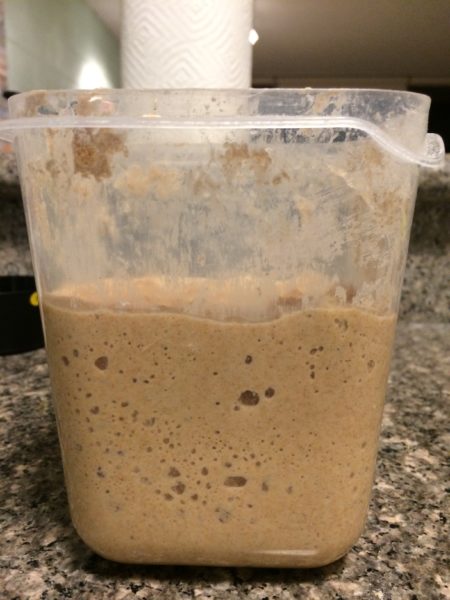
The author’s starter, looking healthy with lots of air pockets.
Flour, Water, Temperature, Time
Semifreddiâs produces 9,500 loaves of sourdough each day. But no two loaves taste exactly alike. And thatâs because the starter is alive with millions of wild yeast cells and naturally occurring bacteria. The yeast makes the bread rise. And the bacteria create the acids that make the bread sour.
The flavors vary from day to day, and batch to batch. Sourdough is one of the most ancient breads, dating back at least 5,000 years. Itâs reasonably easy to create a starter from scratch, but tricky to master the triple arts of crust, crumb and flavor when baking. So much depends on capturing enough wild yeast to make the bread light and airy. (Adding commercial yeast is not a permitted technique at the baking stage if the goal is authentic, old-fashioned sourdough).
âWe try to control it by temperature and time. And our hands. Itâs never fully totally under control, because weâre dealing with natural organisms,â said Rose. âI love it,â he added with a grin.
Rose was so passionate that I decided to try growing my own sourdough starter at home (more on that below).
The Boudin Lore
A little voice nagged at me, though. Anyone can make sourdough, but would it be authentic if it wasnât born in San Francisco? (I live in Oakland).
No one has convinced more people about the unique qualities of San Francisco sourdough than Boudin, which says itâs been selling the same loaf of bread for 168 years. According to the Boudin Bakery museum at Fishermanâs Wharf, the companyâs mother dough follows an unbroken line back to the Gold Rush in 1849. Louise Boudin even saved the starter from a burning building in the 1906 earthquake.
A museum docent told me the starter is so special and irreplaceable that the Boudin mothership sends its retail stores fresh starter every 23 days. Without it, they say the sourdough those stores produce would stop tasting like San Francisco sourdough and start tasting like San Diego or Sacramento sourdough.
Why? Well, according to the museum, Boudin bread owes its special flavor to a strain of bacteria that thrives only in San Franciscoâs climate. Scientists identified it here in 1970, so they named it Lactobacillus sanfranciscensis.
Â
Not That Unique, Actually
Itâs a great story. Too bad itâs not quite true.
Scientists did identify Lactobacillus sanfranciscensis here. But recent studies have found it in up to 90 percent of countries where sourdough is produced. So from a biological standpoint, San Francisco sourdough is not all that distinctive.
âItâs something that everyone thinks is unique to San Francisco and that is not true at all,â said Ben Wolfe, a microbiologist at Tufts University in Boston. His lab studies fermentation full time ⊠including the microbes you find in sourdough.
So, case closed? Not quite.
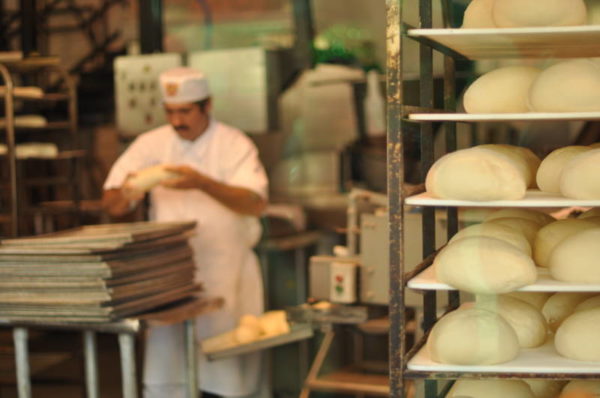
Boudin Bakery says their decades-old starter is the key to the bread’s flavor.
Science is still learning about the lactic acid bacteria (like L. sanfranciscensis) that give sourdough its main sour flavor. Other fermented foods have lactic acids, too, like miso, yogurt and kimchi.
But scientists donât know where they come from. Or how they get into your sourdough starter when you make it in your kitchen.
One explanation is that the bacteria could be in the flour to begin with. So when you go to the store and buy a bag of flour, itâs not sterile. They could also be on your skin or floating around your kitchen, but Wolfe says those are less likely to become the dominant bacteria in your starter.
âThis is one of the big questions weâre trying to answer in our story of American sourdough: Where are the lactic acid bacteria coming from?â said Wolfe.
The Sourdough Project
Thereâs never been a large-scale study in home kitchens to really identify the sources of bacteria at home.
Until now.
Wolfeâs lab has partnered with the Rob Dunn Lab at North Carolina State University on the Sourdough Project, the first comprehensive effort to test the DNA of sourdough starters across America â and understand the evolutionary biology that underlies the differences among starters.
The Sourdough Project is soliciting hundreds of sourdough starter samples from amateur and professional bread bakers across the country. (To participate in this public science project, get started by filling out this questionnaire).
Scientists will analyze samples to answer the baseline question: How variable are the microbes from region to region? And how much variability can be attributed to the grain of the bread, versus the air, the water or the humans involved?
There are so many factors. Wolfe ticks them off.
âIt could be the time that people ferment their breads. It could be the temperature. It could be a special set of recipes used in San Francisco than in other places.â
When I told him I was growing my own sourdough starter, he offered to analyze it.
So while science may yet discover something special is lurking in our sourdough, Wolfe isnât holding his breath.
Not even the bakers at Semifreddiâs, a company that has been in a position to benefit from the reputation of local sourdough, embrace the cachet.
Semifreddiâs head baker Tredgold says itâs pure marketing.
âIt sells the city. Itâs one of the things the cityâs known for. The bridge, the bay, the sourdough.â
And Rose, the co-owner of the bakery, added: âIf we take our local starter and bake with it in Los Angeles, I think it will taste very similar to what weâre making here,â he said.
Blasphemy! But possibly ⊠true.
My Kitchen Sourdough Experiment: Results
My own sourdough experiment lasted more than a month. I used King Arthur whole wheat flour and kept my mixture on the kitchen counter. As it grew, it smelled distressingly like vomit before it mellowed. At one point it almost spilled out of the Tupperware Iâd been keeping it in.
As my starter matured, it needed to be fed twice a day on a regular schedule. I raced home from work to give it more flour and water, spoke to it, and pampered it with field trips out to the balcony to give it some exposure to the Oakland atmosphere. (In spite of what I learned about the uncertainty of the science of microbes in sourdough, I still pictured my starter capturing beneficial wild yeast and bacteria from the atmosphere.)
I donât have pets or children, so I took photos of my starterâs regular maturity and forced my friends to admire them.
But the most important question was: How did it taste? I baked two little loaves and brought them into the KQED newsroom to get some brutally honest feedback from fellow reporters.

Julia Scott, left, and Bay Curious podcast host Olivia Allen-Price enjoy the fruits of Scott’s labor in the KQED newsroom — some homemade sourdough bread.
Being a first-time baker, you can imagine how this went. The loaves were so dense they had almost no air pockets. They weighed at least 3 pounds and were nearly rock-hard. My colleagues at KQED charitably praised the taste, but it was clear something had gone wrong in the baking process ⊠or with the starter itself.
A few weeks later, I got my sourdough DNA results back from Ben Wolfeâs Tufts lab. My starter had two bacterial species: Lactobacillus brevis and Lactobacillus plantarum; and one yeast species: Wickerhamomyces anomalus. All of which are very commonly found in sourdough starters made around the world, according to Wolfe. Itâs also common to have no more than a few species of yeast and bacteria in any given starter.
But that one bacterium once believed to make our bread so special â Lactobacillus sanfranciscensis? My bread didnât have any. Would things have gone differently if it had shown up? I may never know.
Tags: Bacteria, Bay Curious, Boudin Bakery, Food, Julia Scott, KQED, lactobacillus sanfranciscensis, microbiome, Semifreddiâs, sourdough
Posted in Podcast and Radio Work | No Comments »
The Loneliest Man in Belize
Thursday, May 1st, 2025
‘Rozco! Love you, hon!â cried a man in baggy jeans. His shout, insincere and taunting, was aimed at the back of Caleb Orozco, a 41-year-old man walking along a row of tarp-covered souvenir stands near one of Belize Cityâs ferry terminals. Orozcoâs only acknowledgment was to walk a little faster, car keys clutched in his hand. It was a hot December afternoon, a week before Christmas, high season in the cityâs tourist zone. Two policemen appraised Orozco but said nothing as more taunts flew. âSaw you on TV!â a woman dressed in white jeered from her craft stand, where she sold carved wooden boats. Farther down the sidewalk, two men snickered. âCaleb! You done rub too hard!â leered a man in a blue baseball cap, pointing to Orozcoâs crotch.
âBatiman!â someone called from the shade of a foodÂ-cart umbrella.
In Belize â a small Anglophone Caribbean nation tucked into the eastern flank of Guatemala and Mexico â âbatimanâ (Creole for, literally, âbutt manâ) has long been the supreme slur against gay men, the worst possible insult to their personhood and dignity. But now another slur is beginning to take its place: âOrozco.â
Five years ago, Orozcoâs lawyer walked into the Belize Supreme Court Registry and handed over a stack of papers that initiated the first challenge in Caribbean history to the criminalization of sodomy. Caleb Orozco v. the Attorney General of Belize focuses on Section 53, a statute in the Belize criminal code that calls for a 10-year prison term for âcarnal intercourse against the order of nature.â If Orozco won, his supporters hoped, it would establish a moral precedent across the Caribbean and even create a domino effect, putting pressure on other governments to decriminalize sodomy. But it took three years for the Supreme Court to hear the case; two years later, the nation still awaits a verdict.
In the meantime, Orozco operates the United Belize Advocacy Movement, or Unibam, the only gay Ârights advocacy and policy group in Belize, out of his home in a thick-walled compound on Zericote Street, where stray dogs nose for food scraps in the dirt. The walls are topped with broken shards of glass and rusty, upside-down nails. A seven-foot-tall security gate barricades his driveway. When home, he must remember to lock all six locks â two for his house, two for his office and two padlocks on the gate for good measure. Those precautions do not prevent Orozcoâs neighbor or people walking by his house from throwing rocks and bottles over the walls, shouting, âAala unu fu dedâ (âAll of you should dieâ). Other residents have picked up two-Âby-fours and chased him in the street. People stone Orozcoâs house frequently enough that he rarely bothers to call the police at this point. (This being Belize, a country with a population of just 360,000, he sometimes knows whoever is throwing the rocks on Zericote Street anyway.)
Orozcoâs natural habitat, the place where he feels powerful and at ease, is in front of his pink laptop in his office, a squat outbuilding with barred windows. Inside these walls, no one will disparage his manner of dress: snug graphic tee, stylish camo-print shorts and black Keds that hug his feet like shapely hooves. No one will comment on the way he styles his hank of hair, with a flip to the left and some highlights that tend to come out looking gray. He greets clients and funders with a soft handshake and a wry joke â usually at his own expense. When they leave, he spends hours online in the growing dark, sometimes past midnight.
âDid you know we caused the floods in Belize?â he remarked airily, scrolling through headlines on a local news site. âThereâs an actual comment from a man who says so.â Later he double-Âlocked his office doors and led the way across a yard strung with empty clothing lines, dry grass crackling underfoot. He paused for a few moments, listening for unrest from his neighborâs house, before mounting the heavily sagging steps. He jerked open the sticky door. The floor tipped at an angle, and the ceiling was patched and moldy. One window had holes big enough for him to poke his head through. âMy house is like my life â a hot mess,â he said, making his favorite joke with a wan smile.
He is Belizeâs most reviled homosexual and its most ostracized citizen, a man whom fundamentalists pray for and passers-by scorn; a marked man at 30 paces. His weary face is on the evening news and in newspaper caricatures, which have depicted him in fishnets and heels. His name is now a label, one used to remind other gays that they are sinners and public offenders. Win or lose, Orozcoâs fight for his fundamental rights and freedoms will follow him for the rest of his life.
Americans and Europeans visit Belize for all the things that make âthe Jewelâ an ideal place to relax: coral reefs, paradisiacal white beaches, a green-azure sea. It is a deeply Christian country, with a Constitution that proclaims the âsupremacy of Godâ as a first principle. Recently, it has seen a surge in Pentecostalism and other proselytizing strains of faith. Although bounded on two sides by Latin American countries with more liberal attitudes toward same-sex relationships, Belize retains a culture more closely aligned with Caribbean countries whose perspectives were colored by 200 years of British occupation. There is an ethos of âlive and let live,â but only as long as the gay community remains invisible. Gay couples cohabitate and quietly raise children, but without demanding legal recognition. Couples donât hold hands in public. No hate-crime laws exist to punish targeted assaults.
Formerly British Honduras, Belize gained independence in 1981, inheriting most of its governing documents from its former master. Section 53 is an artifact of Belizeâs colonial past dating to the 1880s. The British bequeathed similar âbuggeryâ laws to all 11 other Caribbean countries once ruled by the crown. (The Bahamas has subsequently removed them.) Buggery became a criminal offense in the England of King Henry VIII in 1533. Of the 76 countries that still criminalize sodomy around the world today, most do so as a holdover from British colonial rule. (Britain repealed its buggery laws in 2003.) In Belize, antiÂgay laws extend beyond the criminal code: Homosexuals are still technically an explicit class of prohibited immigrants, along with prostitutes, âany idiot,â the insane and âany person who is deaf and dumb.â
Much as with Lawrence v. Texas, the case whose resolution in the United States Supreme Court invalidated anti-Âsodomy laws still on the books in 13 states, Orozcoâs challenge is less about sodomy than about discrimination. Even the most zealous Christian leaders, the ones leading the crusade to keep Section 53 on the books, acknowledge that law or no law, sodomy does happen in the privacy of bedrooms in Belize â and not just between gay men, either. Despite the fact that the law is rarely enforced, Orozco and his lawyers say that the threat of indictment encourages public harassment, threats and occasional violence against many gays and lesbians, who have little recourse. The police sometimes charge hush money not to turn people in, according to Lisa Shoman, one of Orozcoâs attorneys. The Belize attorney general told me that he personally believes that Section 53 is discriminatory, though his office is obligated to defend it in court.
Orozco is an unlikely instigator of this challenge. He wasnât politically galvanized until he was 31, when he went to a workshop for gay men and people living with H.I.V. at a public health conference in Belize City. One by one, the men stood up, spoke their names and added, âI have H.I.V.â or âI have sex with men.â Orozco was bowled over. âI got up and said, âBy the way, I like men.â I realized that you perpetuate your own mistreatment by remaining silent. And I decided I would not be silent anymore.â
A year later, he helped found Unibam as a public-Âhealth advocacy group for gay men. Until that point, Orozco had never paid much attention to the H.I.V. epidemic in his country. Even after one of his uncles, who was gay, died from complications related to AIDS, Orozco didnât fully grasp what had killed him. He couldnât acknowledge being gay â to others or himself â until well into his college years. âPeople would ask me, âAre you gay?â And I would say stupid things like: âIâm trisexual. Iâll try anything just once,âââ he recalled. âThe truth was, I wouldnât try anything.â He didnât have sex until he was 23, and when he did, he felt pressured into it. He has never had a long-Âterm boyfriend. The men Orozco knows wonât be seen with him. âThere was one man who would only want me to pick him up after 8 oâclock at night,â he said, rolling his eyes. âI think about it all the time â is this the price Iâm paying? To have no love life? To be the one publicly gay man in Belize? To be the most socially isolated?â
Orozco did not have litigation on his mind at an H.I.V. conference in Jamaica in 2009 when he spoke to two law professors â one Jamaican, one Guyanese â with the University of the West Indies Rights Advocacy Project, which they had recently founded with a colleague to focus on human rights in the Caribbean. They had been studying bans on same-Âsex relationships, laying the groundwork for a test case that, if successful, could encourage similar legal challenges in neighboring countries. Belize was ideal: It had a Constitution with stronger personal privacy and equality protections than other Caribbean countries. From a human rights point of view, it was a case they thought they could win.
When Orozco heard this, he recalled, âI put up my hand â literally â and said: âWhat about me? Iâm ready since yesterday. How can we do this?âââ But even as he signed the legal papers, litigation itself was never the point. âI realized the case was simply a tool to create a national dialogue,â he said. âIt isnât just Section 53. Itâs adoption. Itâs Social Security. Itâs not having the first say of the health of your partner. Thereâs the dignity issues, which havenât been recognized.â
The legal challenge was a controversial move in Belizeâs gay community, where the question of gay rights â what they are and how to get them â is a conversation that has just barely begun. Belize has never had an inciting incident to catalyze a movement, like the 1969 Stonewall uprising. There is no annual Gay Pride parade. No member of government or other prominent figure has ever come out. No gay bars or ritual âsafe spacesâ exist as places for people to meet, just carefully organized house parties and private encounters on Facebook. The L.G.B.T. community in Belize, with the exception of a dedicated corps of organizers and supporters, remains timid, fractured and apolitical. Unibam itself has only 128 members, in part because of peopleâs concern that their names could be made public. âDonât ask, donât tell â thatâs the way with just about everything here,â said Kelvin Ramnarace, a Unibam board member. âIt doesnât mean progress. Itâs one thing to not have rights and know it. Here you think you do, because itâs not so hard to live here. But we donât.â
But Orozcoâs lawyers had reasons to hope that a softening was at hand. The tone had already begun to shift across much of neighboring Latin America, where activists were laying the groundwork for a string of victories. Today, six Latin American countries recognize same-Âsex marriage or civil unions. Eleven countries have banned employment discrimination based on sexual orientation, and seven countries protect L.G.B.T. citizens against hate crimes.
âEven though people said they anticipated some backlash in Belize, almost all the groups I spoke to seemed favorable,â said Arif Bulkan, the Guyanese lawyer Orozco met at the H.I.V. conference. Bulkan and his colleagues spoke to a range of Belizean civil-Âsociety groups and local leaders, including those in the church establishment. He recalled an important meeting with the president, at the time, of the Belize Council of Churches, which encompasses Roman Catholics, Anglicans, Methodists and Presbyterians. âHe said they wouldnât support us openly,â Bulkan said, âbut they wouldnât oppose us either.â
So Orozco had few reasons to think he might regret putting his reputation, and Unibamâs, on the line. Today, he shakes his head like a man in a dream. âI just thought it was going to be some litigation,â he said. âI didnât expect opponents, didnât expect propaganda and all that other stuff that happened.â He paused. âI really didnât.â
In Belize, church leaders are granted deference in the press and by lawmakers on social issues. But in large part, the ecclesiastical focus has always been on the spiritual rather than the political realm. So Orozco was blindsided by the announcement, soon after the suit was filed, that the Roman Catholic Church of Belize, the Belize Evangelical Association of Churches and the Anglican Church had together joined the case on the governmentâs side as an âinterested party,â a legal distinction that allowed them to hire lawyers, file motions and be heard during the trial. More than 400 church leaders and ministries came together to mobilize their adherents in the name of public morality. In another first for Belize, church leaders founded a nationwide activist campaign, Belize Action, and began drawing thousands of believers to rallies that denounced the âhomosexual agenda.â
The churches also flexed their legal muscle in a pretrial motion to remove Unibam as a claimant in the case; as an organization, they argued, it had no standing to challenge the law. Their motion succeeded. Suddenly Orozco was the sole claimant. The case would come down to whether Orozcoâs personal human rights had been violated. He was hounded for interviews, and his name was broadcast all over the world. Someone posted a video to YouTube called â[Expletive] Unibam dis da Belize,â with a photo of Orozco. He received death threats when his name was printed. Shoman, an opposition senator in the National Assembly of Belize as well as one of his lawyers, received explicit rape threats. One day, Orozco was walking downtown, alone, when a man on a bicycle, shouting antigay slurs, threw an empty beer bottle at Orozcoâs head. It smacked him on the jaw and cracked two of his molars. After taking his statement, âthe police said, âIf you find who did this, tell us, and we will pick them up.â Why is that my responsibility?â he asked me with a sardonic smile.
Before the churches joined the case, Orozco allowed three organizations to join forces as an interested party on his side: the Commonwealth Lawyers Association, the International Commission of Jurists and the Human Dignity Trust, major transnational nongovernmental organizations with global standing, large budgets and access to the best human Ârights lawyers in the world. âI thought that using interested parties from the international community would have brought some kind of leverage,â he told me.
But the presence of these foreign groups, even on paper, allowed Orozcoâs enemies to reframe the case as an act of cultural aggression by the global north. According to Bulkan, âa lot of the negative press after that was about foreigners coming in.â Prime Minister Dean Barrow told a local news station: âOne of the things that we have to be grateful for in this country is the culture wars we see in the United States have not been imported into Belize. Well, obviously, this is the start of exactly such a phenomenon.â The United States and Europe were meddling colonizers, Orozco their traitorous pawn. Orozcoâs religious opponents referred to victories for same-Âsex marriage in California and Canada as further evidence of the true agenda at work in Belize. âIt puts a lot of pressure on us,â Orozco said. âWhen we started this, we werenât thinking about gay marriage.â
Opponents made much of the fact that Unibam receives all of its budget, around $35,000 a year, from foreign governments and foundations, including the Canada Fund for Local Initiatives, the Swiss Embassy in Mexico City and the Open Society Foundations. âIs Unibam being used for a foreign gay agenda?â one news station asked. The Amandala, the nationâs largest newspaper, published a page-Âlong editorial under the headline âUNIBAM DIVIDES BELIZE.â âHomosexuals are predators of young and teenaged boys,â wrote the editor in chief, Russell Vellos, in a separate column. âWoe unto us, Belize, if homosexuals are successful in our court. Woe unto us! In fact, since ours is a âtest case,â woe unto the world!â
Six days a week, Orozco drives to his motherâs squat rental in a Belize City suburb and sits down at her glass kitchen table. Perla Ozeata, a matter-Âof-fact woman with the same dark eyes as her sonâs, serves up his favorites: steaming dark bowls of chimole, a Belizean specialty; escabeche with chicken and whole jalapeños; and her special cheesecake. Strangers have cursed her for âencouragingâ her son to be gay, but she is proud of him. The first day Orozco went to court, he wore clothes his mother bought him. She ironed his shirt and tied his tie. Sometimes when she looks at him, she still sees the friendless schoolboy who played in the yard by himself, catching lizards and trying to avoid his bullies and his fatherâs chronic disapproval. She intends to one day tear down the house on Zericote Street and rebuild, so she can move back in with him and protect him. âSomebody have to live with Caleb, because people take advantage of him,â she told me one afternoon. âCaleb no fighter. He can fight out the mouth, but he canât fight physical.â At one point, when Orozco was out of earshot, she said in a low voice: âEvery time he walk the street, they promise to kill him. Win or lose the case, theyâll kill him.â
These days Orozco leaves his compound on foot for only two reasons: to walk to the bank (10 minutes) or to the market for groceries (five minutes). On good days, he can make the 10-minute walk in seven and the five-minute one in three. But even inside a place of commerce, things can go awry. âA gentleman said he wanted to push his bat up my you-Âknow-Âwhat,â Orozco told me at one point. âI was at the bank. I had my nieces with me.â
He was sitting on his messy bed, his knees pressed together. His clothes were jammed into a dresser decorated with peeling childrenâs stickers. Twice a day, Orozco brushes his teeth over the tub because he doesnât have a sink. The walls are a single run of wooden slats with holes like gapped teeth, so pests are a problem. âCompare rats to spiders, and I prefer spiders,â he said.
Coming out is supposed to broaden your world. Orozcoâs world has narrowed to the space between these walls. Some days the tension in his neck hurts so badly that he resorts to painkillers. Other days he just feels numb. He doesnât answer his cellphone when it rings and just watches TV until he drops off to sleep. âI donât like feeling trapped,â he acknowledged. âBut I cannot afford to lose myself in this work. I create my own social space, completely.â
Once in a while he takes a chance on a night out at Dinoâs, a dance club in downtown Belize City. But he never goes without a friend. At midnight one Saturday, Orozco parked near a faded billboard with a picture of a sad-looking woman and the message âABORTION: ONE DEAD, ONE WOUNDED.â With his sister Golda, her husband and a friend, he ascended a narrow concrete stairwell to a long, dark room with earsplitting Caribbean dance music. âThis is what we do,â Orozco said, shrugging. Itâs an in-Âjoke that Belize Cityâs only gay-friendly club is on Queen Street. Drag queens have performed as dancers and singers, but on most nights, like the night we visited, the club is filled with straight couples grinding up against the plywood walls. âNot a lot of gays here,â I said. Orozco replied, âThatâs the challenge.â
There were a lot of watchful eyes at Dinoâs. Camo-clad security guards, grim-faced and armed, scanned the crowd for troublemakers. Hand-painted brontosaurs and stegosauri stared out from the walls, rendered with cartoon menace in Day-ÂGlo colors under black light. As the dancers watched one another, they took in Orozco, taller than most Belizean men at 5-foot-11, as he stood by the door for a long time in burnt-Âorange slacks and natty brogues, sipping a Coke over ice. He watched them back, seeming very ill at ease.
Orozco counted eight members of his tribe in the room that night. He knew all their names, professions and stories. But in four hours, only one, a contractor who had done some work with Unibam, approached Orozco and his group to say hello. Orozco approached no one at all. âI donât have many friends,â he acknowledged later on. âYou turn left, you have criticism. You turn right, you have indifference.â He has warm relationships with his clients and colleagues, but he doesnât socialize.
Ramnarace, the Unibam board member, told me that he supports Orozco as a leader, but that others in the gay community have their doubts. âInternationally, I think he is more accepted than he is locally,â Ramnarace said. âBecause when he says certain things here, he doesnât always come across well.â In interviews, Orozco can appear peevish or overly cerebral, seeming impatient with his interviewer or else resorting to the programmatic lexicon he uses at human rights meetings. âBut still,â Ramnarace went on, âheâs a brave little bitch to go do that, even to fumble. It isnât easy to do, not here, not alone, a little Hispanic guy.â
Orozco used to love going out dancing late at night. One memorable time at Dinoâs, he made out with a man in public, right there on the dance floor. Tonight, he and his small group formed a circle in the darkest part of the room. Golda began to dance in her gold sandals and light flowered dress, smiling at her older brother in an encouraging way. Her husband and their friend danced at her sides. Orozco, expressionless, planted himself near a pillar and began moving in place, gazing down at the floor. âAs long as I donât see an eye looking at me, I can lose myself in the music,â he said. âI just donât want to be conscious of anyoneâs eyes looking at me.â
It has now been 24 months since the hearings on Section 53, with no word on when Chief Justice Kenneth Benjamin will deliver a decision. The Supreme Court does not have a calendar for decisions, and sources close to the case have refused to speculate as to the cause of the unusual delay. The Supreme Court Registry did not answer a request for comment. âUnfortunately, civil matters in this country do proceed at a very slow pace,â Shoman said. âBut I could never have imagined that something of this magnitude, a case regarding the personal liberty of the citizens, should take so long.â She and the rest of Orozcoâs legal team have sent multiple letters to the registrar general but received no reply.
Jonathan Cooper, the chief executive of the Human Dignity Trust, is just as eager for results. âThe ramification of the Belize decision will be felt across the Commonwealth, if not beyond,â he told me. Because either side is likely to appeal any decision all the way to the Caribbean Court of Justice, the highest court for not only Belize but also Barbados, Dominica and Guyana, the controversy (and Orozcoâs notoriety) is likely to spill over into those nations as well. And then there is the matter of international human rights law. The legal groups invoked the International Covenant of Civil and Political Rights in their argument, with the knowledge that should the appeals court rule in Orozcoâs favor on that basis, other jurisdictions would find the criminalization of sodomy very hard to justify.
After waiting so many years, Orozco has made a decision of his own. Shortly after the court hearings, he quietly stepped down as the president of Unibam. He stayed on as its executive director, but he told me that he hopes to leave that post next year. âIâve come to realize that Iâve sacrificed my life to this work,â he said. âAnd I wake up to an empty bed and a pillow. And what does that say about me?â
These are not the words of a Harvey Milk revolutionary, and in fact Orozco doesnât see himself in the mold of Milk, who was murdered at 48. But Orozco has believed for some time now that he wonât outlive his middle age. âMy larger goal is to survive to the end of my case,â he said. âThey said that if something should happen to me, the case would be over. Iâve invested seven years of my life in this thing, and I donât want to throw that away.â
Orozco has come to the conclusion that the big changes he thought were within reach five years ago are actually a generation away. Living in Belize as a gay man or woman is like peering across a demilitarized zone with a pair of binoculars. If he took a four-Âhour bus ride to Chetumal, Mexico, Orozco would enjoy the right to marry. Someday, Orozco may tear down his house and rebuild it. He may go to law school or pick up the business-administration career he left behind. But he has ruled out leaving Belize. He loves his family too much. He hopes that with time, most of his fellow Belizeans will learn not to judge. âOur opponents have been fear-mongering,â he said. âMost people could care less what I do in my bedroom.â
One afternoon, Orozco took his least favorite walk, to the bank. He rose from his office chair, turned off the fan, cut the lights, locked all six locks and stepped out in a brown tie-dye button-down and kneeÂ-length cotton pinstripe shorts. The narrow downtown streets were clogged with cars short on mufflers, long on horns. He passed bakeries and pharmacies and street vendors hawking bags of peanuts and dried fruit and discount clothing stores blaring pop music.
Stoop-Âsitters on Central American Boulevard nudged one another and gestured. A man in a truck driverâs uniform, smoking a cigarette, quietly watched Orozco go by, then spat and uttered a profanity. Two adolescent girls turned to look back at his retreating form, then doubled over with laughter. Three construction workers, legs dangling in a muddy trench, looked up as Orozco walked past. âHey, Belize bwai!â they shouted. âHoo da fayri, butt bwai?â
A few steps from the bank, Orozco passed two women alongside a young girl with her hair tied back in braids, wearing gold sandals and a flouncy white dress. She gazed at Orozco with curiosity. Then she looked up. âMama,â she said, âthatâs a batiman.â
Tags: anti-gay, Belize, Belize Action, Belizean, buggery, Caleb Orozco, Caribbean Court of Justice, Caribbean gay rights, gay and lesbian, Julia Scott, LGBT, New York Times Magazine, Scott Stirm, section 53, sodomy law, Unibam
Posted in Front Page | No Comments »
Shut In Together: 119 Neighbors and Me in an Oakland Condo
Wednesday, April 30th, 2025
I have a confession. I donât know most of my neighbors. I donât even know the names of everyone on my floor. I live in a tall condo building in Oakland, with a towering view of Piedmont and the surrounding neighborhoods. Itâs the kind of building where you can nod to a neighbor for years, without thinking about the interaction.
No more. Because right now, almost all of us are home together. Thinking about, or trying not to think about, the virus. Our lives intersect in new ways. Our interactions will follow suit.
COVID-19 has transformed my world. My one-bedroom is now my office, tiny gym and portal to the friends I miss hugging and to my parents, who are holed up in the North Bay and havenât set foot outside since shelter-in-place orders took effect.
In recent days, Iâve struggled with my emotions and video chatted with my therapist. Iâve had good days when I am overwhelmed with gladness to be part of a team at KQED whose coverage of this pandemic, deemed an âessential service,â has become more essential than ever.
Iâm not the only one in my building whoâs struggling to find our way in a new landscape with no view of the horizon. The coronavirus is an unspoken part of every interaction. And the fear is there, too. We fear getting each other sick, and we fear what might happen to us if we were to fall ill. My 119-unit building has about 180 residents. For the next few weeks or months, weâll almost all be living and working here in our little units, separated by a concrete wall and under one roof. I started wondering: How are we all coping so far?
Our âLand-Based Cruise Shipâ
I put up a note on the bulletin board in the mail room, asking my neighbors to reach out and tell me their stories. The first one who did was Gina Belleci, who lives on the sixth floor. She and her girlfriend, Jessica Holt, have been sheltering together since Ginaâs startup sent everyone home. She now telecommutes from a small table wedged next to the kitchen, while Jessica works with her laptop propped up on a dresser in the bedroom.
Gina says some of her days are spent in âsilent panicâ mode. Other times, she feels optimistic. Gina and Jessica take care of their neighbors. Lately they’ve been handing out toilet paper and grocery shopping for an elderly friend on the eighth floor, who really should not leave the building.
âI think we just really need to band together. And these small, tiny ways really add up,â said Gina. âIt’s generosity breeds generosity. I feel really excited to be part of this building to see what happens here.â
Jessica is a freelance theater director, and she told me that her prospects have become extremely uncertain, very quickly. All of her upcoming theater productions have been canceled, and the same is true industry-wide.
âThis is all I’ve really practiced as a trade, as a craft, my entire life,â she told me. âI’m not going to lie â the other night, I sort of threw myself into a little heap. And I and I keep saying, well, we’re going to get through this. There will come a time when we return to normal. But will we? Will we ever be able to return to normal? I don’t know.â
They told me that theyâve made the difficult decision to leave. Ginaâs 74-year-old mother lives in Antioch and doesnât have anyone to take care of her. They worry that the longer they spend in a building with 180-odd people, the likelier they are to pick up the coronavirus and bring it back to Ginaâs mother.
âI either need to choose being with her, to be able to go get things for her just to keep her in the house, or we need to really commit to this land-based cruise ship we live on â which is so big and has so many people coming in and out,â said Gina.
So theyâve packed their suitcases for a month and said goodbye to their neighbors.
Sheâs right about the sanitation issue. Our buildingâs maintenance man has gone home, and there is no cleaning regime, which I suspect is true of many large apartment buildings here in the Bay Area.
In a building like mine, where space is limited, itâs nice to be able to open your door and have a conversation with someone you meet by the elevators or in the mailroom. But each of those touch points now could be vectors for infection. Elevator buttons. Door knobs. Iâve taken to wearing gloves just to go downstairs or when Iâm in the laundry room. When people see you inside an elevator theyâre waiting for, they give a tight smile and wait for the next one. Even the mailroom has started to feel a little snug. People donât linger to enjoy those conversations anymore.
So it was a pleasure to receive a text from my neighbor Dina Mackin on the third floor. âWant to meet up on the roof to see the sunset?â it read.
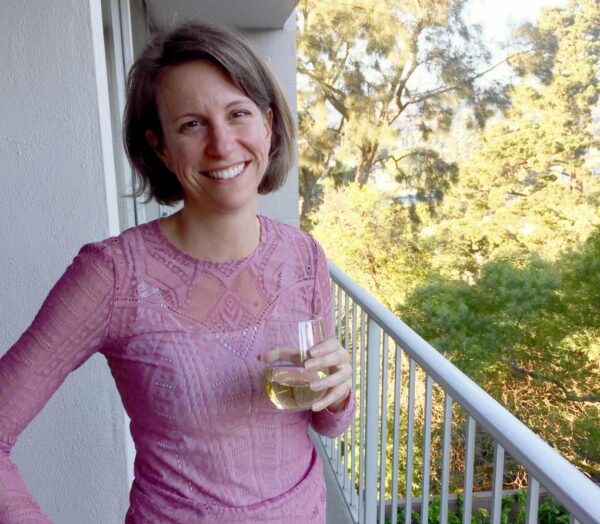
Dina Mackin.
When I got there, Dina had a glass of rosĂ© in her hand and was standing in front of a darkening view of West Oakland and in the distance, the Golden Gate Bridge. âThis is what I have to do every day to keep my sanity,â she said. âThe beauty of just seeing something so simple that happens every single day, that marks the passing of time. You just appreciate it more and more. And this is the time to appreciate it.â
As she spoke, I realized that I hadnât been outside in two days. This was the first time Iâd tasted fresh air. When days start to run together, watching the sunset is an important form of closure. Even better to watch it with a neighbor.
Dina agreed. âThis is one of the few things we’re still able to do,â she said.
On the Front Lines
Katie Stephenson, my neighbor on the second floor, cannot shelter in place because she is a second-year pediatrics resident at Kaiser Permanente Oakland Medical Center. I barely see her as she darts in and out to shower, sleep and drink some coffee before heading back out to the hospital for another 12-hour shift.
I spoke to her on an evening she had just tested negative for COVID-19. She had a post-allergy season cough so her doctor sent her to have a test. But she assumes that itâs only a matter of time before she does get the coronavirus, so sheâs careful to limit her contacts within the building.
âMy mission is just to keep my germs confined to my little space and not let them get out,â she said. âBut I also think that if I’m one of the people who gets COVID-19, that I would do fine â most people my age, if weâre healthy, we do fine. I think a lot of people in my residency program, myself included, are very likely to get it and are very likely to do fine.â
Katie has been on the pediatrics ward for the past three weeks. She sees children who have been admitted because their parents are afraid they might have COVID-19. All medical staff must wear personal protective equipment â essentially hazmat suits â and masks around the children, which is profoundly unsettling.
âThere are nurses wearing the suits, and there’s multiple doctors coming in wearing the suits. Itâs scary,â she said. She tries to defuse the fear by making her young patients smile. âI have some stickers that my mom sent for St. Patrick’s Day. They’re all green. And so I have been bringing in stickers and putting them on my suit. Or Iâll draw like a smiley face, to be a big yellow smiley-face person.â
Katieâs supervisor has told her group that theyâre running a marathon, and so far theyâve only run half a mile. They need to remember to pace themselves. Luckily, Katie is an actual marathon runner â sheâs done three of them â so she knows when to push herself. Her freezer is stuffed with homemade dinners prepared by her mother â a source of comfort at the end of another long day.
My neighbor Alexa Eurich is also running a marathon of sorts. Somehow, sheâs had to find a way to teach her combined classroom of kindergarten and first grade students from her apartment on the fourth floor. Eurich has taught at Aurora School in Oakland for 15 years. The school closed down so quickly that no one had time to grab enough teaching supplies for a month, let alone the rest of the school year.
âWhen you hear about teaching kindergarten remotely, you just have to laugh … because how is that even humanly possible?â she said. âIt’s been very hard not knowing, because I’ve felt competent at my job for a very long time.â
Alexa has 16 kids in her classroom. She manages to video chat with four of them each day, in addition to checking in regularly with teachers and parents. Sheâs trying to keep up with the lessons her kids were learning two weeks ago, but she has to improvise with whatever books the students have around the house. They have to be trained to talk to her through a computer screen. It can be hard to connect.
âI know without a doubt that the best way we humans learn is through a relationship. And not being with them physically when they’re at this developmental stage is very trying to the relationship,â she said.
Itâs also been trying for her. Because she is in remote meetings all day, her husband has to stay in the bedroom for hours at a time.
âI’ve been working from, like, six o’clock in the morning to about six o’clock at night,â she said. âAnd I am still in love with teaching. I love my job. But I’m not in love with this job right now. I have to learn how to do it in a way that feels wrong to me.â
Staying Sane Inside Four Walls
I asked my neighbors what they are doing to stay sane amid deeply uncertain circumstances. My neighbor Guillaume Chartier and his husband Grant Eshoo have been baking lemon meringue pie and watching âStar Trek: The Next Generationâ after they have finished the dayâs work at their improvised desks in the living room. (Guillaume is an animator, and Grant works for Alameda County).
They chose to re-watch Star Trek for its nostalgia, but are finding that it holds surprising relevance to our present moment on Earth.
âThere was an episode where they were facing a lethal epidemic and they had to take measures to contain it,â said Guillaume. Of course, they succeeded â thanks to Dr. Beverly Crusher.
âIt displays a very earnest, optimistic outlook on humankind. And we’re just the kind of nerds that we enjoy watching it together,â he added with a laugh. âIt’s all imaginary settings, but it touches on very current real human conditions and phenomena.â
My second-floor neighbor Judith Rosenberg is in her mid-70s. She reckons she now spends 90% of her time indoors, except for a brisk daily walk or to pick up groceries. She escapes into serial mysteries and spy novels by authors like John le CarrĂ© and Charles Cumming. She also emails with her friends, which alleviates some of the âoverriding sadnessâ she has started to feel.
âI have felt depression in my life. Iâve felt all sorts of emotions, but I don’t get sad very much. This is a deep sadness,â she said.
Her other great comfort is music. Judy has a gleaming concert piano in her apartment. Her specialty is musical improvisation.
âI feel a certain life force when Iâm playing,â she told me. âWhen I sit down to play, there’s something about that experience that makes me feel more alive in a way. And it is a great gift.â
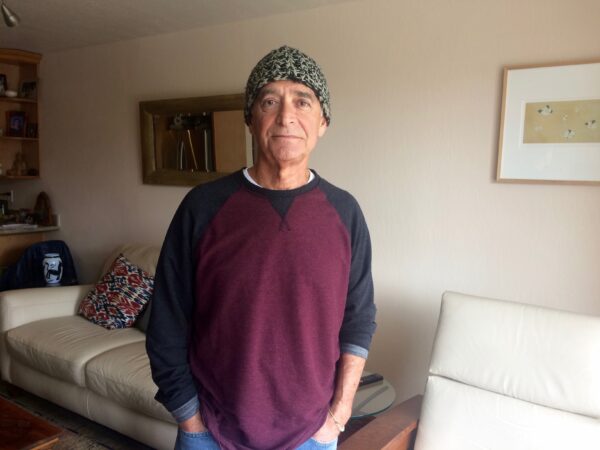
Ernesto Victoria at home. (Julia Scott)
My third-floor neighbor Ernesto Victoria is also in his 70s. He isnât much of a worrier, but he did get concerned a few weeks ago when he developed a cough. His doctor assessed his symptoms and ruled out the coronavirus. Still, the cough has been hard to shake.
âI get a little scared from time to time, I have to be honest with you,â he said. âThe other day, the symptoms were really bothering me. And I just got really emotional.â
He pulled out his computer and started writing memories of his childhood in Mexico and of growing up with his seven siblings.
âMaybe there was this thought, you know, of, ‘If I die, I want my daughters to see this,â â he laughed. âI was just feeling sentimental and emotional.â
Ernesto loves swimming, biking and hiking. With his pool closed and his favorite biking and hiking trails off limits, his daily pleasures include video chats with faraway friends.
âIt is so good to see a face and to talk. It’s the joy of talking with somebody after being sequestered for so long,â he said.
A lot of nice little things have happened in my building over the past two weeks. I was happy when Ernesto accepted my offer to shop for him sometime soon. Someone on the third floor left a message on the bulletin board offering to help anyone who needs it. Another neighbor organized the entire seventh floor into a group text, so that when someoneâs leaving for a grocery run, they can take requests and minimize the number of trips from the building.
I know this virus will escalate in the next few weeks. The news will get scarier. But Iâve met more neighbors in the last week than Iâve gotten to know in the past five years. I already feel better knowing I have so many people to talk to who are facing the same situation, the same questions, as I am. We may all be behind our doors for now, but we really are in this together.
Tags: Coronavirus, COVID-19, Julia Scott, KQED, shelter-in-place, The California Report
Posted in Podcast and Radio Work | No Comments »
Duolingo: Extreme Sports Heroes
Friday, April 11th, 2025
EPISODE PART 1:
Sibusiso and the Big Mountain
Sibusiso Vilane has stood at the summit of the worldâs tallest mountains. He is a mountaineering icon from South Africa, who has ascended Mt. Everest twice. He has reached the greatest heights in the world… but growing up, he never even thought about climbing a single mountain, until fate intervened and changed the direction of his life forever.
His first conquest of Everest put him in the history books as the first Black man from Africa to make it to the top. But the message he carried back to all South Africans was even more important to Sibusiso: one of equality of potential and ability, at a time when the country was still emerging from the painful legacy of apartheid.
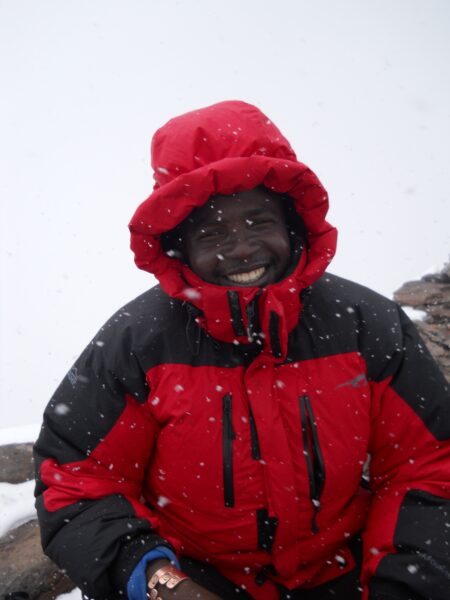
EPISODE PART 2:
Bianca’s Big Wave
Bianca is a professional extreme surfer. She has surfed big waves all over the world. But there was always one wave that scared her the most: the Mavericks surf break, in California. Along the way, conquering Mavericks also became a battleground to fight for equal opportunities for women in surfing.
Today, thanks to the advocacy of Bianca and other female surfers, surf contests are starting to treat women equally to men — including them in all the major contests and awarding them the same prize money when they win. But the fight is far from over.
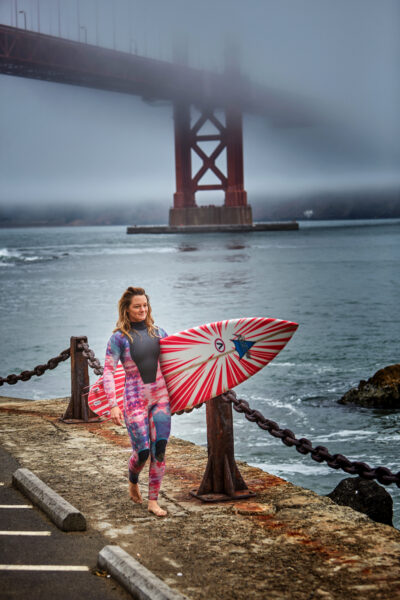
Tags: Bianca Valenti, big-wave surfing, Duolingo, extreme sports, Julia Scott, Mavericks, Mavericks surf contest, mountaineering, Mt. Everest, podcast, Sibusiso Vilane, South Africa
Posted in Podcast and Radio Work, Uncategorized | No Comments »
Letter of Recommendation: Candle Hour
Tuesday, March 18th, 2025
One of my best teenage memories starts with a natural disaster. In January 1998, my parents and I returned to our home in Montreal to find that a giant tree limb had ruptured our living room. What would soon be known as the Great Quebec Ice Storm had struck. It was the most catastrophic in modern Canadian history. Accumulations of freezing rain had cracked our maple tree nearly in half. It shattered our front window, glass fringing the tree limb like a body outline in a murder scene.
Outside, downed power lines sparked like electric snakes. More than a million Quebecers were left without power. Cars were crushed and impaled by fallen limbs. Because the ice could inflict violence at any moment, everyone retreated indoors, making for an oddly quiet state of emergency. Except for the distant beeps of electrical-crew trucks, all you could hear was the crack of trees buckling under the weight of the ice, day and night. Long after the sidewalks were cleared, we tiptoed past the eaves of tall buildings and kept our voices low, steering clear of icicles thick as baseball bats and sharp as spikes, primed to fall at any moment.
For seven days and seven nights, until the power returned, we lived by candlelight. We learned to be mindful of candles: how to stand them up, walk with them, nurture their light. At first it was maddening to cook dinner â to carefully carry a plate of candles to the cupboard, poke around for ingredients, then go off again in search of a knife, taking care not to drip wax into the cutlery drawer. I learned how to brush my teeth and bathe by candlelight; the light bounced off the mirrors, making the bathroom for once the brightest room in the house. In our bedrooms, we piled under blankets and read ourselves to sleep by the flickering flames.
Outside, our neighborhood descended into darkness at twilight, but if I stared hard enough at windows blurred with ice, I could just make out little dancing lights. Decades later, no one in my family remembers what we talked about, or ate, or how we spent our afternoons that week. But we all remember the candles.
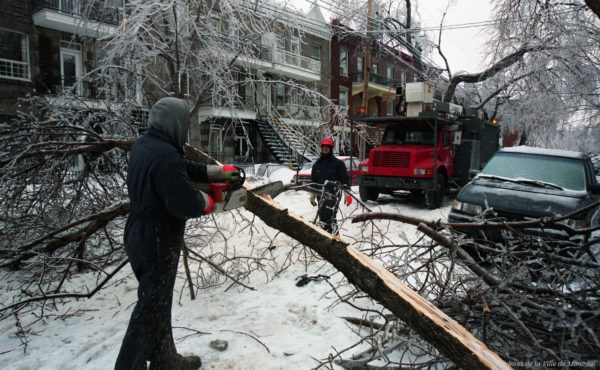
The Montreal Ice Storm, 1998. (Archives de Montreal)
Iâve since settled in California, and last January events in the world left me with a hunger for silence. I adopted a strict information diet: no television news or social media. One evening, I didnât even bother to flick on the lights in my apartment. I walked quietly to the window and watched the last of the day, the darkness swallowing the trees along my street. Instinctively, I went looking for a book of matches in the back of the kitchen junk drawer. Opening a closet, I felt around until I discovered the remnant of a housewarming gift: a milk-white candle. I struck a match and lit the dusty wick. I commandeered a plate from the cupboard and set it on my coffee table. I nestled in a blanket, listening to the wind in the courtyard. Eventually, for the first time in too many days, I found myself surrendering to sleep.
That was the start of a practice Iâve taken to calling Candle Hour. An hour before I go to bed, I turn off all my devices for the night. I hit the lights. I light a candle or two or three â enough to read a book by, or to just sit and stare at the flame, which, by drawing oxygen, reminds me I need to breathe, too. I surround myself with scents and objects I like â some fresh rosemary plucked from a neighborâs bush, a jar of redwood seed pods. I have a journal ready, but I donât pressure myself to write in it. Candle Hour doesnât even need to last a full hour, though; sometimes it lasts far longer. I sit until I feel an uncoupling from the chaos, or until the candle burns all the way down, or sometimes both.
Candle Hour has become a soul-level bulwark against so many different kinds of darkness. I feel myself slipping not just out of my day but out of time itself. I shunt aside outrages and anxieties. I find the less conditional, more indomitable version of myself. Itâs that version I send into my dreams.
At night, by candlelight, the world feels enduring, ancient and slow. To sit and stare at a candle is to drop through a portal to a time when firelight was the alpha and omega of our days. We are evolved for the task of living by candlelight and maladapted to living the way we live now. Studies have noted the disruptive effects of nighttime exposure to blue-spectrum light â the sort emanated by our devices â on the human circadian rhythm. The screens trick us into thinking we need to stay alert, because our brains register their wavelength as they would the approach of daylight. But light on the red end of the spectrum sends a much weaker signal. In the long era of fire and candlelight, our bodies were unconfused as they began to uncoil.
Tonightâs candlelight will cast the same glow on my Oakland walls as it did on my parentsâ walls in Montreal in 1998. Iâll feel in my bones that the day has passed â as all days, even fearful ones, eventually do. The dayâs last act is cast in flickering gold. Iâll watch the flame bob and let my mind wander, until I realize Iâm sleepy. After a while, Iâll lean over and blow it out, ready now for darkness â where renewal begins.
Tags: Candle Hour, Julia Scott, Letter of Recommendation, New York Times Magazine, Queben ice storm
Posted in Front Page | No Comments »
My Bed Runneth Over
Saturday, February 15th, 2025
âSo are you guys in an equilateral triangle, or are you more of a V?â
A dark-haired woman leans over to an eager-looking young couple seated next to her and holds up her thumb and forefinger. Each of the V signifies a person; the fleshy connective tissue between them stands for the partner to whom they’re both sexually connected. Her hand gesture is intended as an icebreaker, but the couple pause awkwardly, as if they don’t know exactly how to answer.
In polyamorous relationships, knowing where you stand is crucial, but often hard to figure out. Whether you have 2 partners or 10, managing multiple liaisons can feel like walking a tightropeâwhich is perhaps why the perplexed couple have come to this unmarked warehouse on Mission Street that houses the Center for Sex and Culture. Tonightâs Open Relationship Discussion Group is exploring âThreesomes and Moresomes.â The attendeesâa total of 22 men and women, a commendable turnout for a Monday night in Novemberâsit in a neat circle, jittering with the same blend of excitement and anxiety that you might find in a roomful of people training for their first parachute jump.
Coats still on against the chill of the unheated room, the gathered polyamorists try not to stare too obviously at the painted nudes on the wall, rendered in various poses of masturbation and frottage. Itâs a hip-looking crowd, mostly in their 30s and 40s, white, and flying solo, though there are a few couples and one triad: two women and a man who stroke each otherâs hands and listen, but never speak.
When Marcia Baczynski, a relationship coach and tonightâs discussion leader, asks how many people are new to the group, nearly half raise their hands. Some of them are new to poly altogether, including one smartly dressed woman who met the love of her lifeâa married manâon OkCupid six months ago. With his wifeâs consent, she and the man started a passionate affair. Little by little, the two women grew to care for each other as well, to the point that the three of them now sleep in the same bed.
âIf I hadnât fallen in love with him,â the woman says, âI wouldnât have been able to develop feelings for her. Theyâve been together 17 years, and sometimes I see them as the same person.â She gestures toward the man on her left, who smiles and takes her hand. Then her face falls: The wife, who is not present tonight, is pregnant. âThereâs this other large need that I have,â the woman confesses, âto get married and have kids. Thereâs a huge guilt in me for wanting to date other men. Iâm afraid Iâll hurt him if I do.â She starts to cry. The room is silent until the man speaks up: âIâve told her that the last time I loved someone this much, I married her. I donât know what to do with this.â
Someone asks whether the two of them have talked about having a child together. They have, and they may. âBut thatâs the hard part for me,â the woman says. âItâs so not what my parents wanted for me. Itâs not the social norm.â Everyone nods.
âJealousy, time management, and lack of clarity around what youâre doing.â Baczynski ticks off the three most common pitfalls that beset practitioners of poly. Weâre seated close together on a lipstick-red velvet chaise at Wicked Grounds, a kink-friendly cafĂ© on Eighth Street where you can purchasee hand-carved rosewood butt paddles with your peppermint tea. Curly-headed and bright-eyed, Baczynski exudes friendliness that inspires a tangible intimacy. A decade ago, she gained fame in the alt-sex community as the coinventor of cuddle parties, which began in 2004 with clothed strangers caressing each other in her Manhattan apartment and have spread to thousands of living rooms across the United States and Canada. Now she’s one of the Bay Area’s most sought-after relationship coaches in the poly sphere, thanks in part to the prominence of her online curriculum, Successful Nonmonogamy, which helps couples open up their relationships without imploding them.
Twenty-four years after Sonoma County pagan priestess Morning Glory Zell-Ravenheart conceived the word âpolyamoryâ (meaning âmany lovesâ), the Bay Area poly scene is still the biggest in the country and very much in the vanguard of a movement to disrupt monogamy. Many of its members are more aptly described as âmonogamish,â Dan Savageâs term for couples who stay committed to each other while having sex on the side. (Polyamory also extends to couples who date each other and single people who date around a lotâalthough poly types tend to dismiss cruisers and commitment-phobes as not part of their tribe.) But the variations only spin out from there. The aforementioned V becomes an equilateral triangle when a threesome commits to sharing sex, love, and face time among all three partners. Two couples, or a couple and two singles, make a quad. If a fivesome is connected via a common partner, thatâs a W. Partners may be primary, secondary, or tertiary, though some polys reject those terms as too determinative. A distinction is made between lovers and metamours (a partnerâs partner), the latter often a close friend who steps in to resolve conflicts, cook dinner for everyone, and help raise the kids.
The concepts behind these words are constantly being hashed out in homes throughout the Bay Area, long known as polyamoryâs petri dish. New additions to the vocabulary often bubble up here before filtering out to polyamorists in the rest of the country. âCompersion,â for example, defined as taking pleasure in your partnerâs pleasure with another person (the opposite of jealousy), emerged in the Kerista Commune, a Haight-Ashbury âpolyfidelitousâ social experiment that used a rotating schedule to assign bed partners.
Dossie Easton, a Bay Area therapist who wrote the landmark poly bible, The Ethical Slut, in 1997, gets emotional when she talks about how far the poly world has come since her arrival here as a sexual revolutionary in 1967. âI see people who start out where I fought for years and years to get to. They think that they should be able to come out to their families, that their parents should accept them and welcome all their various partners and their various partnersâ children for Thanksgiving.â
This isnât the polyamory of your imagination, filled with â70s swinger parties and spouse swapping in the hot tub. In fact, the reality of polyamory is much more muted, cerebral, and, well, unsexy. Generally speaking, self-identified poly types arenât looking for free love; theyâre in search of the expensive kind, paid for with generous allotments of time and emotional energy invested in their various partnersâand their partnersâ children and families. All of that entails a lot of heavy lifting, and a lot of time-consuming sharing. âThereâs a joke,â Baczynski says, laughing: âSwingers have sex, and poly people talk about having sex.â
If it all sounds inordinately complicated, thatâs because it is. What do you do when your partner vetoes a potential lover? How do you handle it when your spouse starts dating your ex? To cope with jealousy and the thorny subject of sexual boundaries, the poly community relies on an excess of communicationâhence, discussion groups like tonightâs. The community calendar offers nonstop opportunities for support, conversation, and debate, including potlucks, workshops, coffeehouse socials, political discussions, and book readings. As one woman tells me, people here like to geek out on relationship philosophy as much as they like to geek out on software (and, in fact, the polyamory world has considerable overlap with the tech community).
In the poly world, uncoupling monogamy and sex leads not only to casual sex but also to uncasual sex and, sometimes, uncasual unsex (that is, ritualized cuddling). âI have the freedom to do whatever I wantâand what I want includes taking on a lot of responsibility,â says Baczynski, who is in long-term relationships with one woman and two men. Polyamory isnât about destroying a beloved institution, she argues. Instead, itâs about casting people in the roles that they actually want to play. âThereâs an assumption in our dominant culture that the person youâre having sex with is the person who has all the status and has the mortgage with you, too,â she says. âWhy do sex and mortgages go together? Iâm not sure.â
But freedom comes with a multitude of challenges, many of which were voiced by the following sampling of local poly practitioners. Collectively they provide a glimpse of what itâs really like to be âopen.â
Gloria and Alex and Luna and Joe
Gloria Schoenfeldt wasnât particularly drawn to polyamory, just to people who happened to be polyamorous. First the 31-year-old school-teacher got used to having a polyamorous best friend in Luna Murray, a 25-year-old event planner. Hearing of Lunaâs sexual adventures may have made it easier for Gloria to open her heart to a man named Alex, a 45-year-old photographer and relationship coach who identifies as not only poly but also pansexual.
At first, Gloria didnât want to know about Alexâs other liaisons, other than their namesâshe couldnât take the details creeping into her imagination. But that changed when she realized that she wanted to be a part of his âjoys and sadnesses,â even if they werenât with her. âItâs always worse in my head than it is in real life. Itâs always bigger and scarier and more intense and more likely to cause the end of our relationship,â Gloria says. Now she comforts Alex through breakups and heartachesâand enjoys dating other men as well.
When Gloria introduced Alex to Luna, she was happy to see that they hit it off. The couple also got along well with Lunaâs boyfriend Joe. So well, in fact, that eventually they all became lovers. Last February, the two couples decided to cohabitate, renting a two-bedroom apartment in Berkeley. For the first time in her 31 years, Gloria tried on the poly lifestyle in earnest, taking care to schedule her dates at the same time as Alexâs so as not to feel abandoned. She shares an occasional sexual four-way with her husband and housemates (they call their state of emotional intimacy a âquasi-quadâ). Most of the time, though, theyâre plain old housemates, two linked couples who pool money for groceries and get into tiffs over keeping the house tidy. âWe live together, we have this loving family connection, and I donât know what to call that,â says Alex.
Does it work? It does for nowâone year in is too soon to declare it a permanent success, although the couples are talking about having children of their own. And both couples married last July, in jubilant back-to-back weddings in Orinda and Berkeley (they served as each othersâ witnesses). What keep things stable are the poly-relationship standbys: limits and communication. While they sometimes couple off or have collective sex in the same room, itâs not an orgiastic free-for-all. There are boundaries. Gloriaâs never had one-on-one sex with either Luna or Joe. When dating outside their marriage, Alex and Gloria only have protected sex. Luna and Joe wonât bring home a date who hasnât been vetted by their respective spouse, as well as by Alex and Gloria. Everyone keeps a lid on when Alexâs 12-year-old daughter from a previous relationship comes to stay, although she knows that her dad is poly and has seen him kissing his housemates in a non-housemate-like way.
Still, the arrangement has its challenges. Joe, a 25-year-old server at an upscale Berkeley restaurant, used to get so jealous of his wifeâs lovers that they developed a system: Before she left on a date, she would sit him down and tell him all the things that she loved about him and promise him that she was coming home. Over time, âit got easier and easier,â says Joe. Now the tables have turned. Joe has several lovers, while Lunaâs sex drive has plummeted. Itâs made her insecure and sad. âI used to be this sexual beast, and Iâm feeling very fragile about my sexuality and my body…. Heâll talk about how much he loves his partnerâs body, and Iâll start crying,â she says.
But as far as Gloriaâs personal plunge into poly goes, she considers it a success. She was skeptical of monogamy prior to meeting Alex (âIt doesnât provide the security it claims to, because it canâtâ), but had questioned whether she had the emotional capacity for an open marriage. Seven months in, the answer is yes, this is a good life. So far.
âThe abandonment stuff still comes up,â Gloria says. âWhen that happens, I cry. And we talk. And he holds me and he reassures me.â
Ian
Ian Baker became a practicing polyamorist the hard way: He fell in love with a girl who told him that she didnât want to be monogamousâand then slept with his housemate. âI freaked out,â recalls Baker, but he wanted to be with her nevertheless. âI had to do a lot of work for it to be OK,â he says, âfor my particular psyche to be OK with it.â
That he faced such a difficult adjustment was surprising to Baker, for whom polyamory was hardly a new concept: Heâd grown up in a poly family with three parentsâhis dad, his mom, and his dadâs girlfriendâwho bedded down together every night. They were poor, living in a small cottage in the woods in Sonoma County. Baker, who believes that the arrangement helped keep them all housed and fed, likes to use his story to counter the perception of poly as the domain of oversexed, affluent people with way too much time on their hands. âWhen I was a kid, my parentsâ relationship made perfect sense,â he says. âWhatever situation you grow up in is the situation that makes sense.â
Baker, a developer and CEO of the Y Combinatorâbacked startup Threadable, describes his younger self as an insecure fellow who looked to his girlfriends for validation. He started reading books about jealousy, and slowly it dawned on him that polyamory could help him outgrow his core anxiety. And so he tapped into the poly community for emotional support. âThe only reason that I ever wanted monogamy,â he says now, âwas because I was insecure.â
Baker is in love with Lydia (not her real name), his partner of four years. He doesnât date much outside the relationship, he says, because heâs basically fulfilled. âBut that doesnât mean I want to be monogamous,â he quickly adds. âI like the connections that exploring sexuality brings to my life.â
Lydia, on the other hand, does have other lovers. âShe wants to see other people, and I want her to have what she wants,â Baker says. But every time she takes a new lover, he admits, âI have some anxiety. So when thatâs the case, I have to do a little work. Iâll call someone and chat with them about it for a few minutes, and then Iâll feel better. Itâs not a big deal.â
For poly practitioners like Baker, self-improvement and sexual exploration are overlapping preoccupations. Itâs well-nigh impossible to handle the emotional agitation of concurrent relationships without facing oneâs own self-relationship, they sayâyour resilience must be equal to the task. âThereâs a bunch of different ways that you can learn to be emotionally self-sufficient, and it happens that I learned those lessons by having my girlfriend sleep with my friends,â says Baker, chuckling. âBut since then, itâs been wonderful.â
Sherry
Bespectacled and wearing pink yoga pants, her hair wet after a shower, Sherry Froman leads me up the rainbow staircase to her bedroom and stretches out on her cozy sheepskin rug like a cat in the sun. She has hosted play partiesâfeaturing touching and, sometimes, sexâfor years on these sensuous carpets, beneath tapestry-draped ceilings that evoke four-poster beds. Some of the parties begin with an opening ceremony that resembles a personal-growth workshop: Participants practice communicating boundaries and desires, gaze into each otherâs eyes, reveal the body part that they want to be touched, practice saying yes and no, explore the mattresses laid out on the floor. But, Froman hastens to add, ânot everything is like thatâNew Age, woo-woo spirituality. The poly scene is very diverse.â
When Froman falls for someone new, someone she wants to date for a while, she skips the elaborate lingerie and whips out her calendarânot because she wants to keep her multiple suitors from colliding, but because she wants them to meet. If they form a copacetic bond, she believes, someday they all might cohabitate in the big house that, for now, resides solely in her imagination. That dream was a reality once, 20 years ago at Harbin Hot Springs, just north of Napa ValleyâFroman would walk from house to house visiting friends and lovers who were studying tantric techniques and the full-body orgasm. âI was 23, and all these older men wanted to pleasure me and were fine with me not giving anything back,â she says. âI thought, thatâs different from college boys.â
Since then, Froman has dated her share of supposed polys who hypocritically wanted their women to be monogamous with them. âI think a lot of men have a difficult time with polyamory, because the fantasy looks nothing like the reality,â she says. âBecause if a man has several female lovers in his life, chances are that the women are going to talk about him to each other. And theyâre all going to want him to be comfortable talking about his feelings.â
In the two decades since her time at the hot springs, Froman has learned to resist the pull of NREâthatâs ânew relationship energy,â a poly term for the fizzy bubble of endorphins that envelops the newly besotted. While NRE feels great, she says, the high highs usually lead to the opposite. âYouâve got to think sustainably,â she says. âHow is this person going to work for you over a period of time?â
Froman describes herself as having been a âveryâ sexual person since puberty. (When she decided to lose her virginity at age 16, her mother reserved a honeymoon suite with a heart-shaped Jacuzzi for the occasion and took her lingerie shopping.) After years of casual encounters, she stumbled onto the poly world and started choosing partners for different reasonsâlove, friendship, community. But lately she has again been hankering for more male partners in addition to the long-term beau with whom she shares this four-bedroom in Glen Parkâitâs called âadding on.â
Froman, who met her live-in boyfriend on OkCupid (where users can self-identify as nonmonogamous) more than five years ago, believes that her schedule could support three other live-in men. But how to find them? She used to make promising friends by hosting Open Relationship Community potlucks at her house, but now sheâs trying to explore new social venues to unearth men. âOnce I find them,â she says, âthen all of us being in the same bubble with each other is going to be a lot easier. Itâs like having a family.â
William and Anna
Anna Hirsch thought that William Winters was going to be her first one-night stand. She ended up marrying him. When they met in Baton Rouge, their relationship stylesâhis casual connections, her commitment to monogamyâseemed as mismatched as their temperaments. Then they discovered poly, which squared their deep, if idiosyncratic, love with their desire to avoid the mistakes of relationships past. They agreed to experiment, and when Hirsch left town for several weeks, Winters slept with someone else. He didnât tell Hirsch until she got back.
âShe cried for two consecutive weeks,â recalls Winters. âIt was totally fucking horrible. I remember saying, âAnna, if it is this hard, we do not have to do this.â It was she who said, âNo. There is something in this for me. Iâm choosing this. But we cannot do it your way.ââ
Eight years later, Hirsch, a writer and editor, and Winters, a progressive activist and organizer, are one of the most socially conspicuous poly couples in the Bay Area. In honor of the poly potlucks that they organized for a time, the Chronicle went so far as to dub Winters the âde facto king of the East Bay poly sceneââif you ask, heâll show you a playing card, designed by his friends as a joke, that depicts him as the king of hearts.
Hirsch and Winters live in the Oakland Hills, in a studio apartment attached to a house occupied by several other poly couples. These days, Winters hosts private play parties and enjoys mingling with women. Hirsch is in a four-year relationship with a married couple (sheâs more serious with the husband than with the wife) and has a boyfriend as well. Doing things Hirschâs way means that Winters has the freedom he needs to play, while she puts down roots with the people she loves. Although sheâs legally married to Winters, she likes to âproposeâ to her partners as a way of acknowledging their importance to her. When she mock-married a platonic friend back in Baton Rouge, Winters was her date to the wedding. âI have this whimsical image of myself old on a porch somewhere, someday,â Hirsch says. âAnd I would like William to be on that porch. And I think it would be amazing if there were other people on that porch, too.â This processâfitting together relationships without elevating them or putting them in special categoriesâis described by the couple as âintegrating.â
So why did they marry at all? Winters frowns. âI feel like that question itself comes from a scarcity model that says we only have time for one major relationship. That kind of underlies the dominance of monogamy.â Hirsch has a more practical answer: They were in love, and she needed health insurance. âBut what do I care about what marriage means?â she says. âItâs not a promise. Itâs a celebration of whatâs possible.â On their wedding day, she and Winters nixed vows and simply made a toast.
On the poly success scale, Winters rates their relationship as a 9.8 out of 10. Jealousy? Never a problem. Boundaries? The coupleâs only rules concern safe sex and date disclosures (each a must). Even so, their marriage has been shaken this past year by the same temperament and communication problems that have plagued them since they got togetherâat one point, they put their chances of splitting up at 50-50. For all its laboriousness, polyamory is a deeply gratifying lifestyle for Winters and Hirsch, and the effort that it requiresâthe sometimes Augean task of maintaining multiple messy arrangements all at onceâis more than paid off by the emotional rewards. Still, the day-to-day upkeep of a relationship can test anyoneâs fortitude. âThe poly stuff? So easy,â Winters says. âAnd the rest of it is like, sometimes, why does it have to be so fucking hard?â
Tags: Bay Area sex parties, cuddle parties, Dossie Easton, group sex, Julia Scott, Kerista Commune, Marcia Baczynski, Polyamory, San Francisco, San Francisco Magazine, The Ethical Slut, Wicked Grounds, William Winters
Posted in Front Page | No Comments »
Superlettuce! Extreme weather calls for extreme crops
Saturday, February 1st, 2025
Itâs hot. By 9 a.m., a dusty desert film radiates hazy stillness over thirsty fields of produce. The air is dry as static, and temperatures are well on their way to a blistering peak of 103 degrees in the desert town of El Centro, California, 13 miles from the Mexican border. But Beiquan Mou, a research geneticist with the U.S Department of Agriculture, is buoyant, because his acre-wide field of green and purple lettuce is thriving in these oven-like conditions.
Lettuce is a delicate mistress; it must be coddled and kept below 85 degrees or it will struggle â bad news for Americaâs salads, as scientists claim climate change is poised to turn central California, home to the nationâs âsalad bowl,â into a dust bowl by the end of the century. Most of the year, 60 percent of all the lettuce Americans consume grows in the Salinas Valley, 500 miles from here, cooled by the Pacific breeze. Temperatures there hover at an average of 68 degrees. In El Centro, highs of 106 are not unusual. And that is why Mou is here. Someday, much of Americaâs prime agricultural land will be subject to the same weather conditions that conspired to make 2012 the hottest year on record in the continental U.S. Over the course of this century, North America will see longer periods of extreme heat. Farmers could see annual losses of $5 billion or more.
Meet the Superlettuce
Mou, tall and serious in a round straw hat, armed with clipboard and pen, is picking thick, green heads of iceberg and juicy-looking romaine in leaf-wilting heat. âThe Margarita looks good,â he says, touching a tender butterhead cultivar, blooming in the cracked roseate sand.
Since 2010, Mou has been on an epic quest for the worldâs most heat-tolerant lettuces. Backed by a three-year federal grant, part of a $38 million effort to cope with climate change, he has growtested more than 3,500 varieties of lettuce and spinach in a heat chamber laboratory, exposing them to scorching temperatures and recording the results. The goal: Identify the hardiest species, and isolate their survival genes.
Someday, hopefully, the winners of this gladiatorial death match will wind up on salad plates. The lettuce of the future may look and taste the same, but thanks to the research Mou has begun, its DNA will contain a heat-resistant gene to help farmers cultivate it pretty much anywhere â even the desert.
By late May, Mouâs 84 finalists â 28 icebergs, 28 romaines and 28 butterheads â are ready to be picked and analyzed. They even have superhero names like Gladiator, Jericho, Sniper and Invader. Crouching in pristine, button-down ensembles, Mou and his assistant pile lettuce heads into containers and carry them back to their shade tent. They weigh them, test their firmness, split them open and measure their cores, taking note of tip burn and leaf stress.
Many of Mouâs plants have grown into mutant parodies of supermarket lettuce. Some green-leaf varieties are more than a foot wide with heads bigger than wedding bouquets. Others have cooked in the sun so long they look like burnt marshmallows.
The weirdest-looking lettuces have shot their stems 2Ăł feet into the air, growing leaves in the shape of Christmas trees. Called âbolting,â this is a survival tactic in which lettuce under heat stress tries to flower quickly in an attempt to reproduce.
But Mouâs lettuce has to do more than look good. He bites into a tasty-looking iceberg cultivar called Glacier and makes a face. It is piercingly bitter. âIn the Salinas Valley, that one tastes just fine,â he says, shaking his head. He uses his knife to slit open a neighboring iceberg. He nods in approval. Itâs sweet. It will take trial and error to produce a lettuce that is both hardy and tasty.
Global warming will dictate the worldâs salad bar selection in the not-so-distant future, and Mou isnât the only one rushing to condition our unprepared produce.
One of the USDAâs top objectives in coming years is to identify crop varieties with the most resilient all-weather genes. In addition to Mouâs work, USDA plant physiologists in North Carolina are looking for soybean cultivars that can tolerate elevated ozone and carbon dioxide levels. In Wisconsin, scientists are adapting cranberries to unexpected frost snaps â another regional effect of climate change. In Maryland, researchers are studying crops that deliver better yields with higher levels of carbon dioxide.
Mou wonât have results until 2014. But finding the worldâs first superlettuce is only half the challenge. It will take time â and money â to find a way to crossbreed the lettuce genotypes with other existing strains. Charles Walthall, acting deputy administrator of the USDAâs Natural Resources and Sustainable Agriculture Systems program, says industry leaders like Monsanto are already focused on similar research. Syngenta, for example, has taken an interest in Mouâs study, and sent representatives to one of his lettuce fields.
If all goes well, our lettuce may be more primed than we are to survive the hot, dry times ahead.
âYou think this is hot?â laughs Mou, sweating. âMaybe every day in the future will be this hot.â
Tags: agriculture, Beiquan Mou, carbon dioxide, extreme heat, farming, global warming, Julia Scott, lettuce, Modern Farmer, Monsanto, Salinas Valley, science, USDA Natural Resources and Sustainable Agriculure
Posted in Feature | No Comments »
© 2025 Julia Scott.
